Tucson Nature Photos
I made these sunrise photos of saguaro cacti while on a family holiday trip to Tucson, Arizona.
I made these sunrise photos of saguaro cacti while on a family holiday trip to Tucson, Arizona.
Over the past two years there has been a small revolution in downhill skateboard racing product design. Spurred by advances in technology and rider technique, the big, wide, long downhill longboards we have been riding since the mid 2000s are slowly being replaced by radically smaller, narrower, slalom-inspired setups that place the wheels directly under the rider’s feet.
My friends at Rogue Trucks were early adopters of this trend and have spent the last couple of years perfecting their design for downhill-specific slalom skateboard trucks, which they finally released this year. They asked me to shoot some product photos of the latest run of trucks, which came in an anodized gold and black colorway, so I set up the lights, rolled out the seamless paper, and got down to it.

The newly-released 2019 Madrid downhill boards all feature graphics by the unbelievably talented Tanner Leaser, a hot rod painter and pinstriper out of Texas. A skater himself, Tanner is behind many of the most beautiful and complex helmet paint jobs in downhill skateboarding, including this one on my Ironhead DR-1 aerolid.


Zak Maytum racing at Maryhill in his Tanner Leaser painted original Fasttrack helmet, 2012.
The helmet shell was designed and hand-made by Zak Maytum, a legendary skateboard racer and product designer. Inspired by the Fasttrack speed skiing helmet that was popular among downhill skateboard racers in the late 90s X-Games/Gravity Games era, Zak built the DR-1 with additional interior space to accommodate an EPS foam inner helmet that provides considerably more impact protection, as well as thicker cheek pads to prevent facial injury—Zak suffered a nasty broken nose when he went face-first through some haybales in his Fasttrack—all the while maintaining proportions and styling that keep the helmet looking sleek and aggressive.
The name DR-1 is a reference to “Drenelum,” the Colorado high country creole version of “adrenaline” that was Zak’s helmet brand before he settled on Ironhead. Zak continued innovating in the aerohelmet space with the angular, aggressive DR-2 helmet that came out in 2014; the 2015 Ibex longtail, a trend-setting helmet without shoulder fairings; and the 2018 DR-3, a hybrid longtail with short fairings.

Tanner’s paint job is a tour de force of different techniques, from leafing and airbrushing to special wet-look candy effects and pinstriping. By far the coolest thing I own, this piece of art is like a tiny hot rod that lives on my shelf.
For more aerolids and fancy downhill helmets, check out the Aerolid and Fullface facebook group.
Here's another run I filmed with Dex to promote his Landyachtz pro model, the Gambler.
Dexter Manning is one of the gnarliest downhill skateboarders on the circuit right now, routinely pushing it to the limit on the steepest, fastest, most dangerous roads he can find.
Documenting that radical skateboarding with follow-car footage requires serious driving skill and the ability to read a rider's body language to anticipate potential crashes and hit the brakes.
Dex and I have a great working relationship and trusts me to get the shot without endangering him; so he called me up to film a couple runs to use in the promo video for his new Landyachtz Longboards pro board, The Gambler. This run down Angie's Curves was the fastest follow filming I've ever done, reaching speeds well over 60mph into off-camber turns. I'm very pleased with the outcome.

I just dropped another album of Giants Head photos on Facebook. You can find them here.

I just dropped another album of Giants Head photos on Facebook. You can find the album here. If you like my work and want to support me, consider donating on Patreon.
I went up to British Columbia for the tenth (!) annual Giants Head Freeride last week and shot a grip of photos. Here's the product of one freeride run on Wednesday morning.
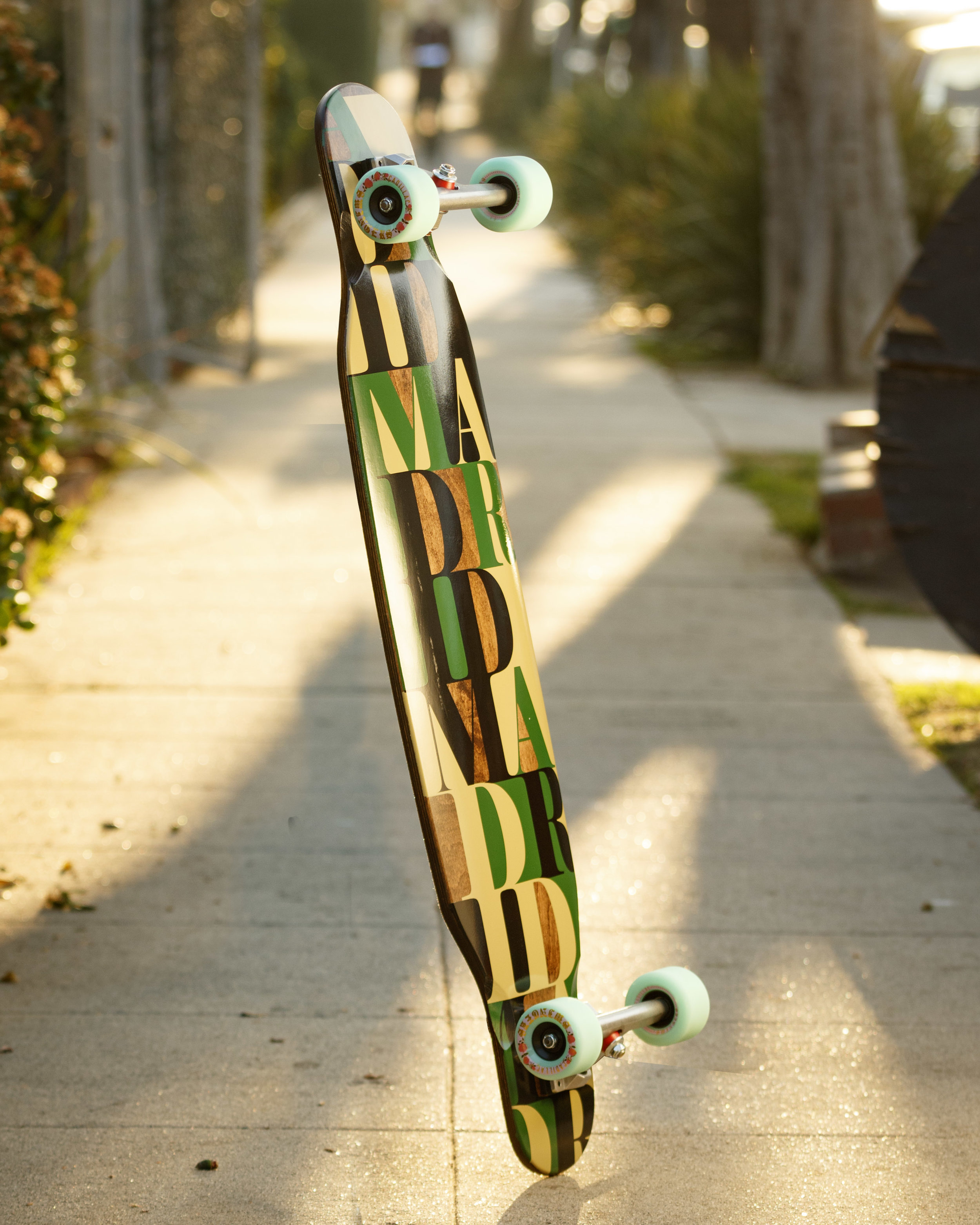
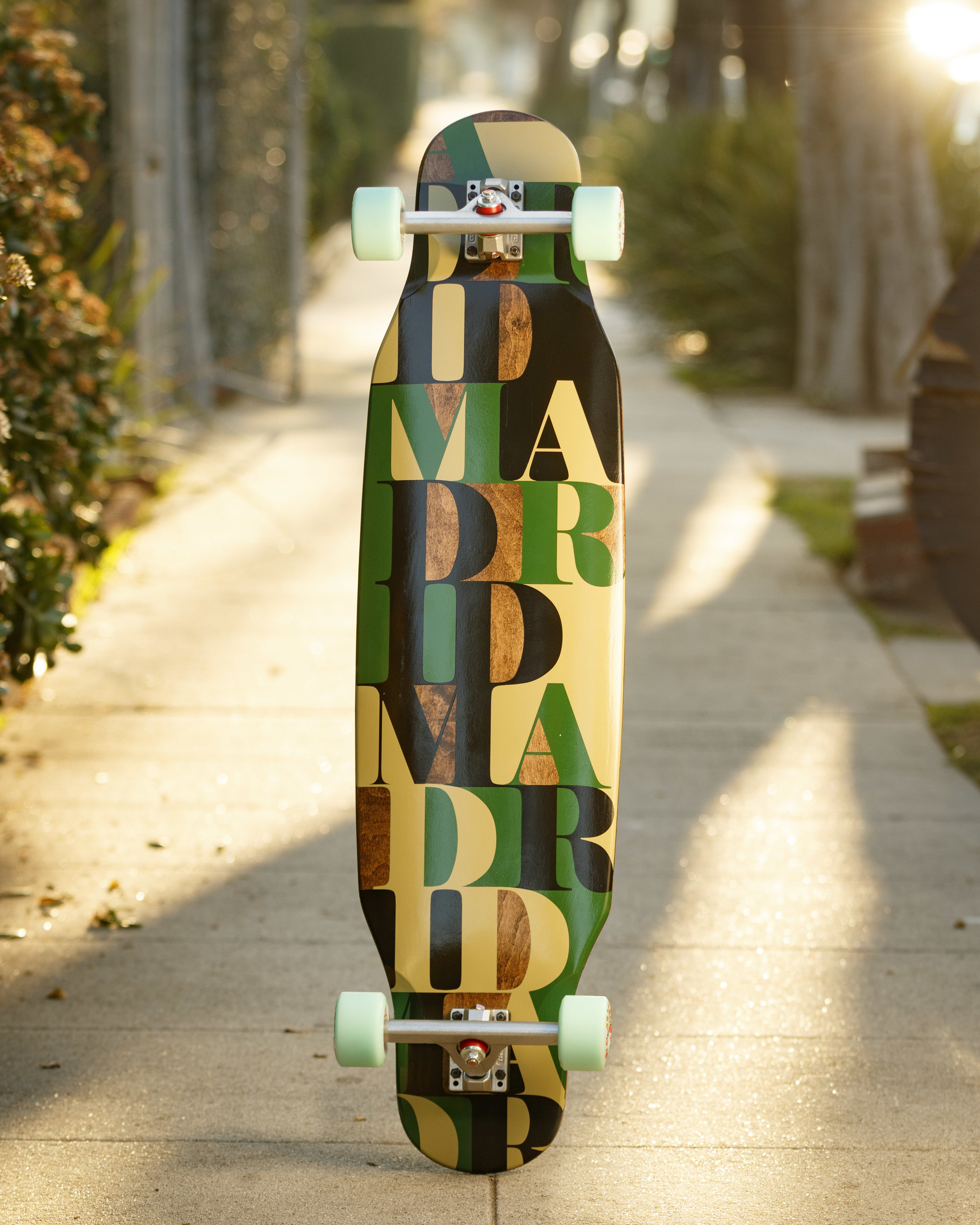
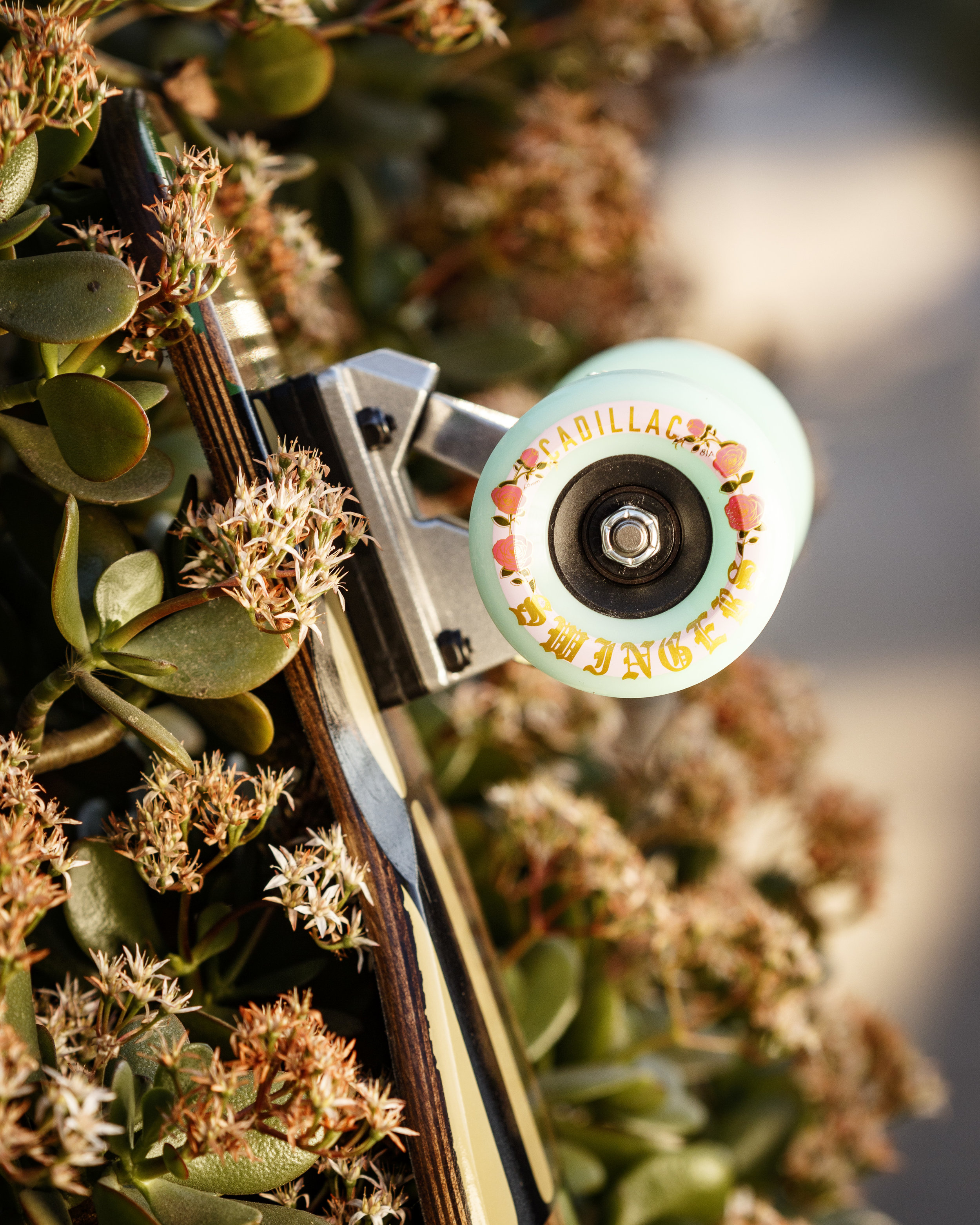
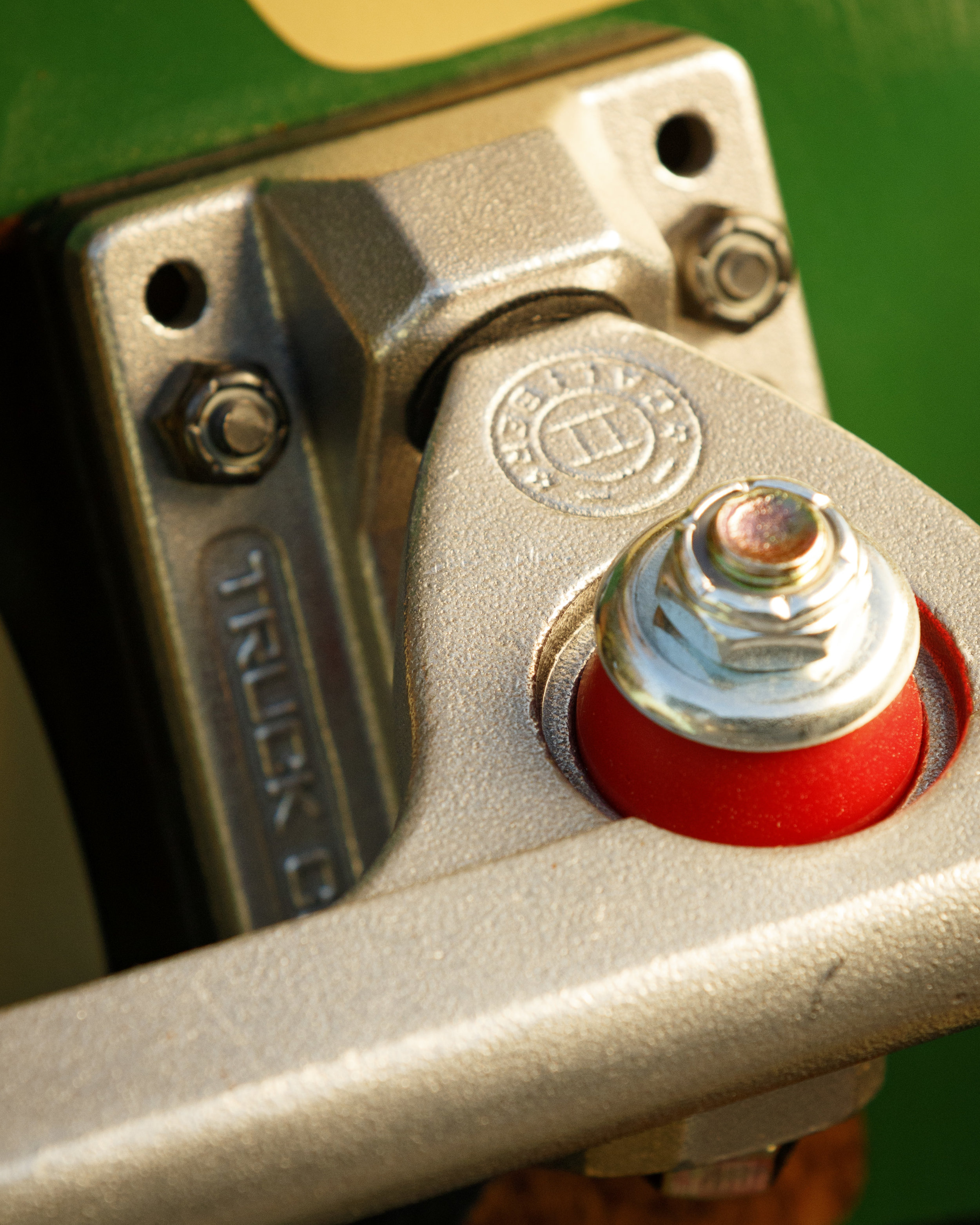
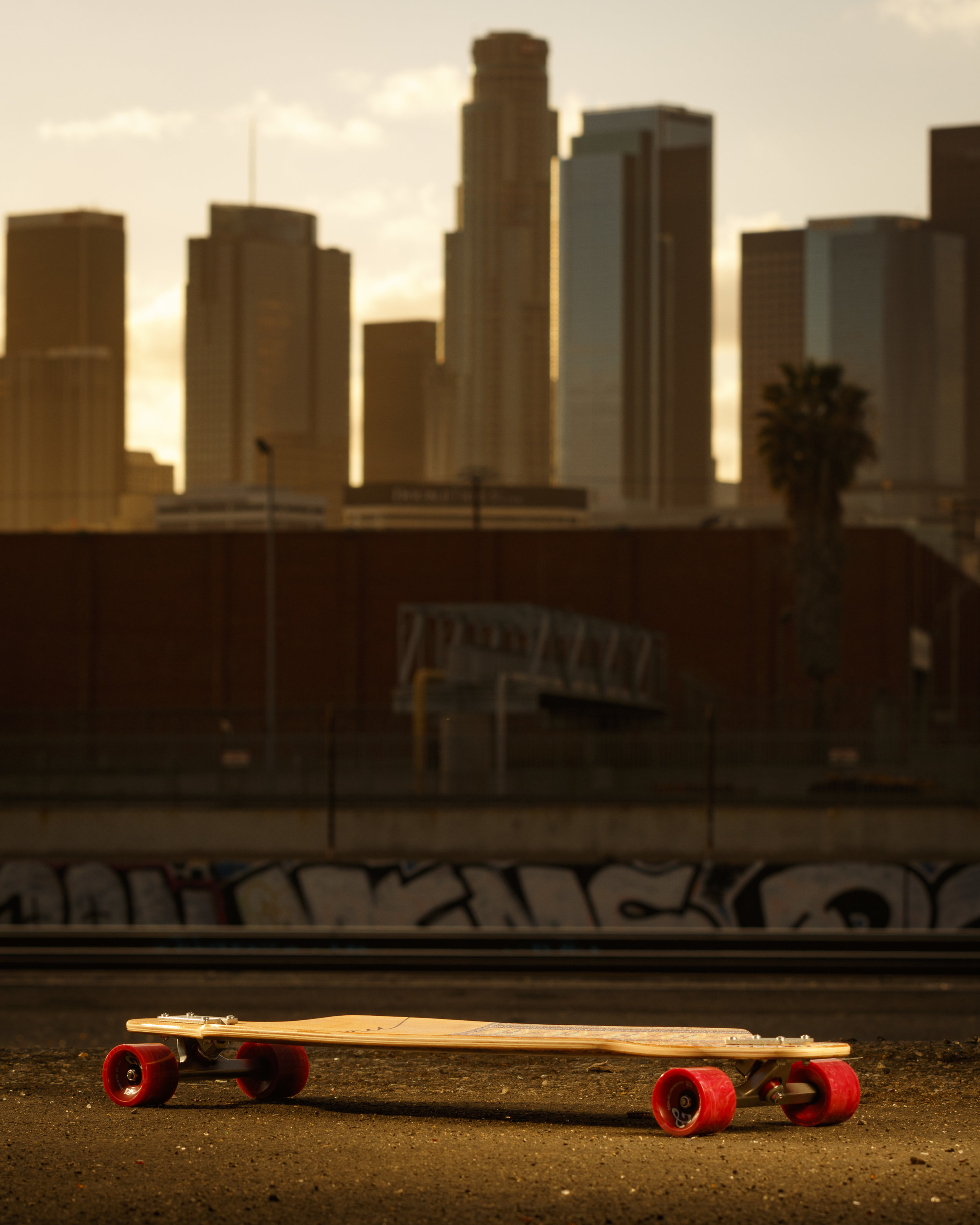
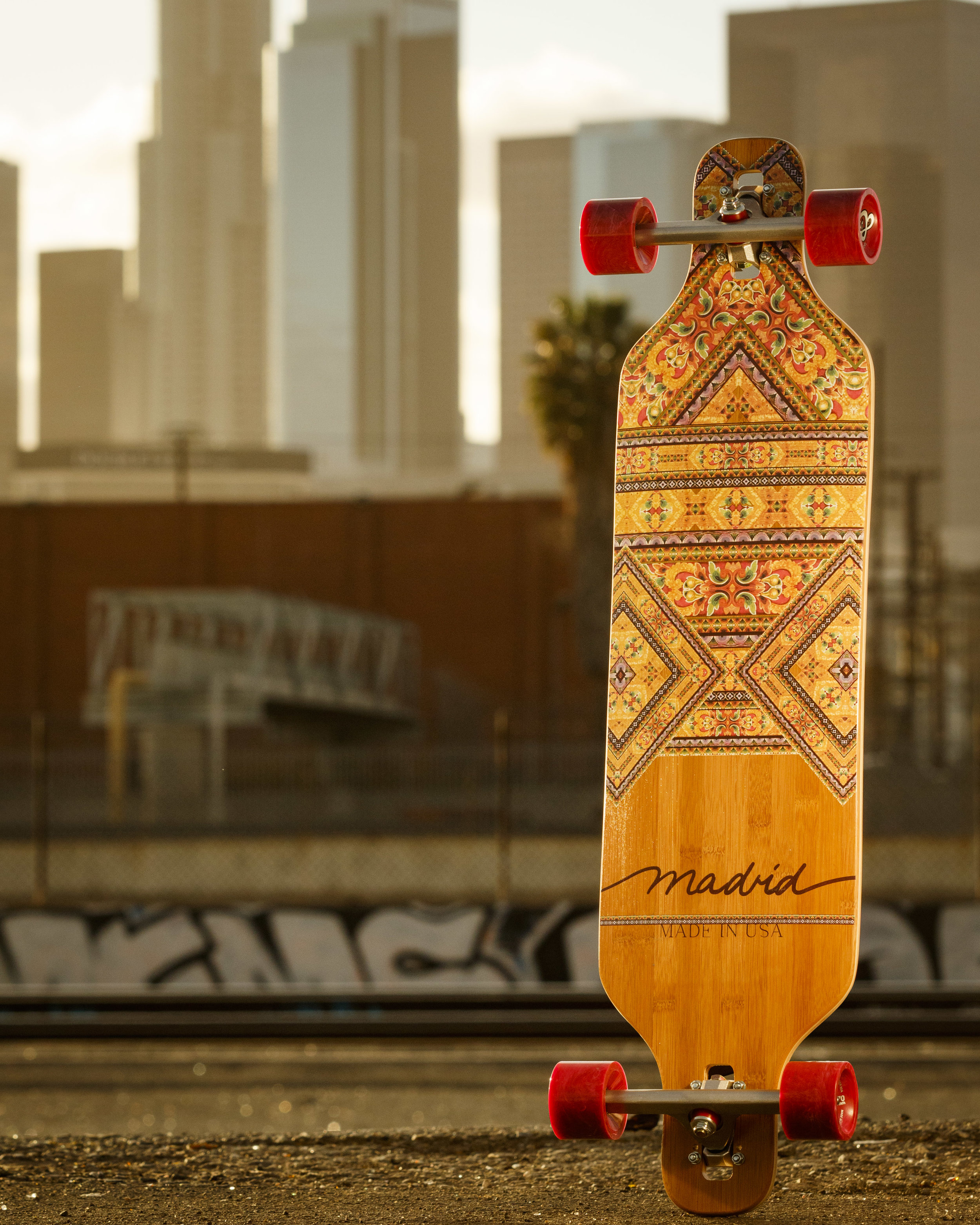
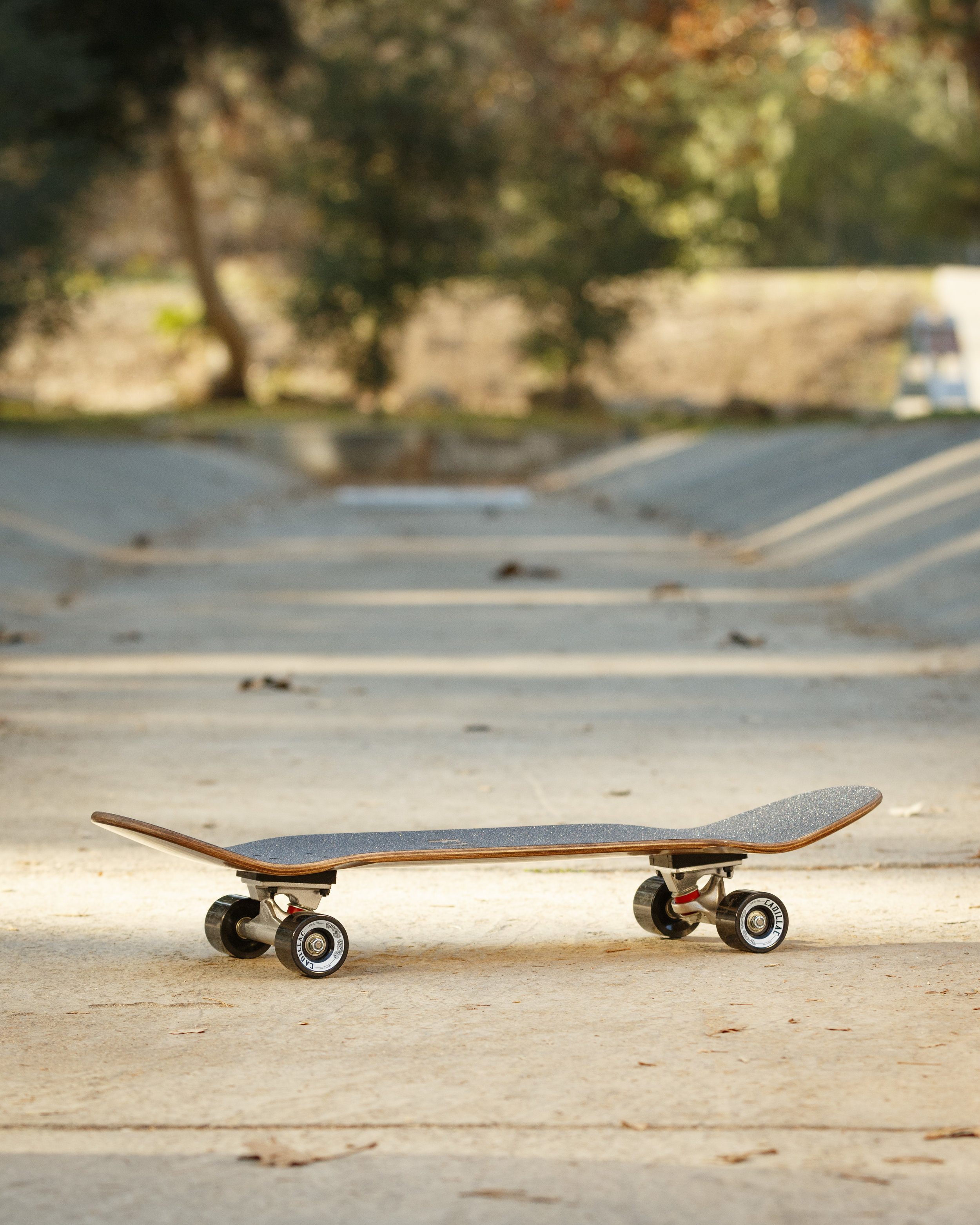
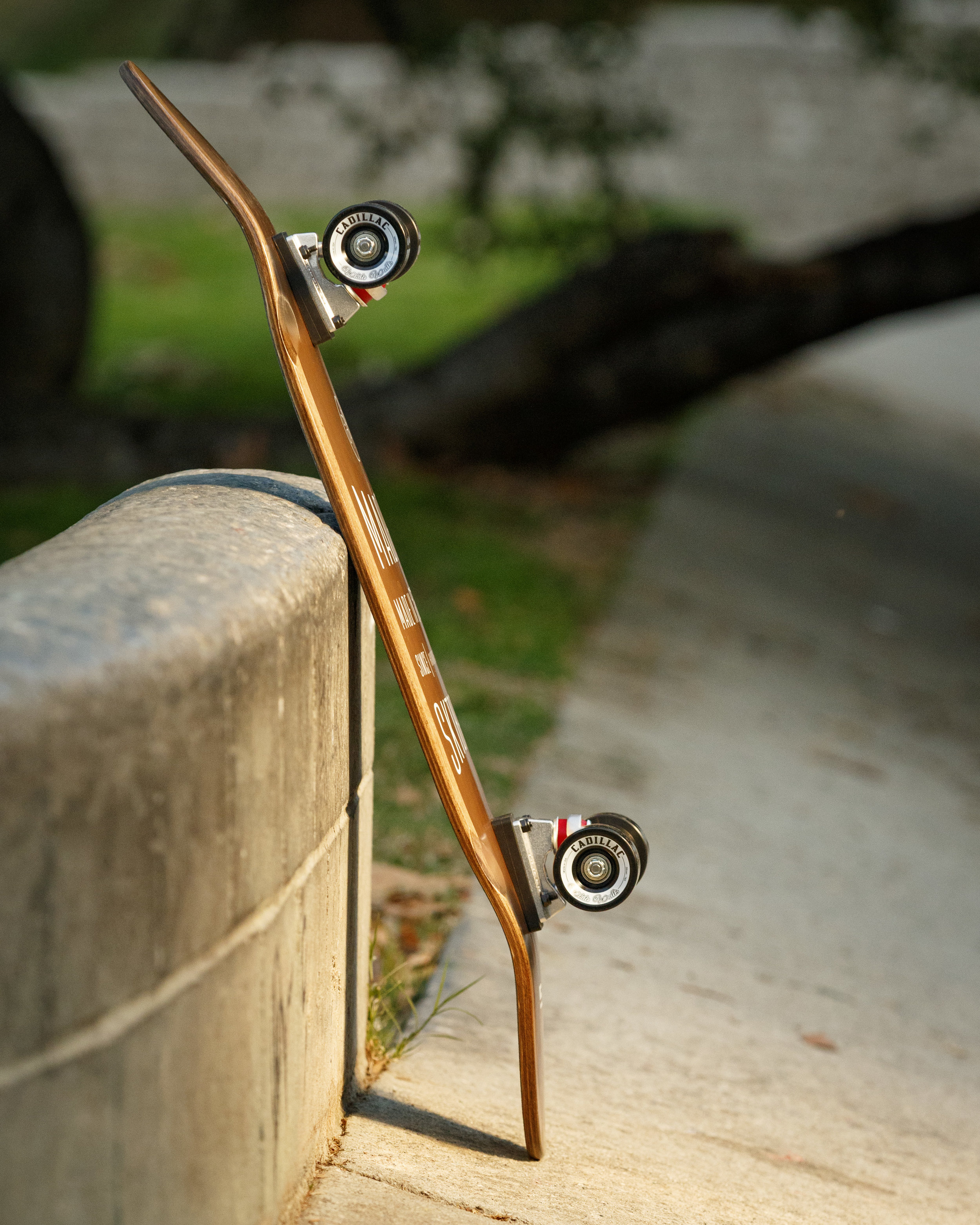
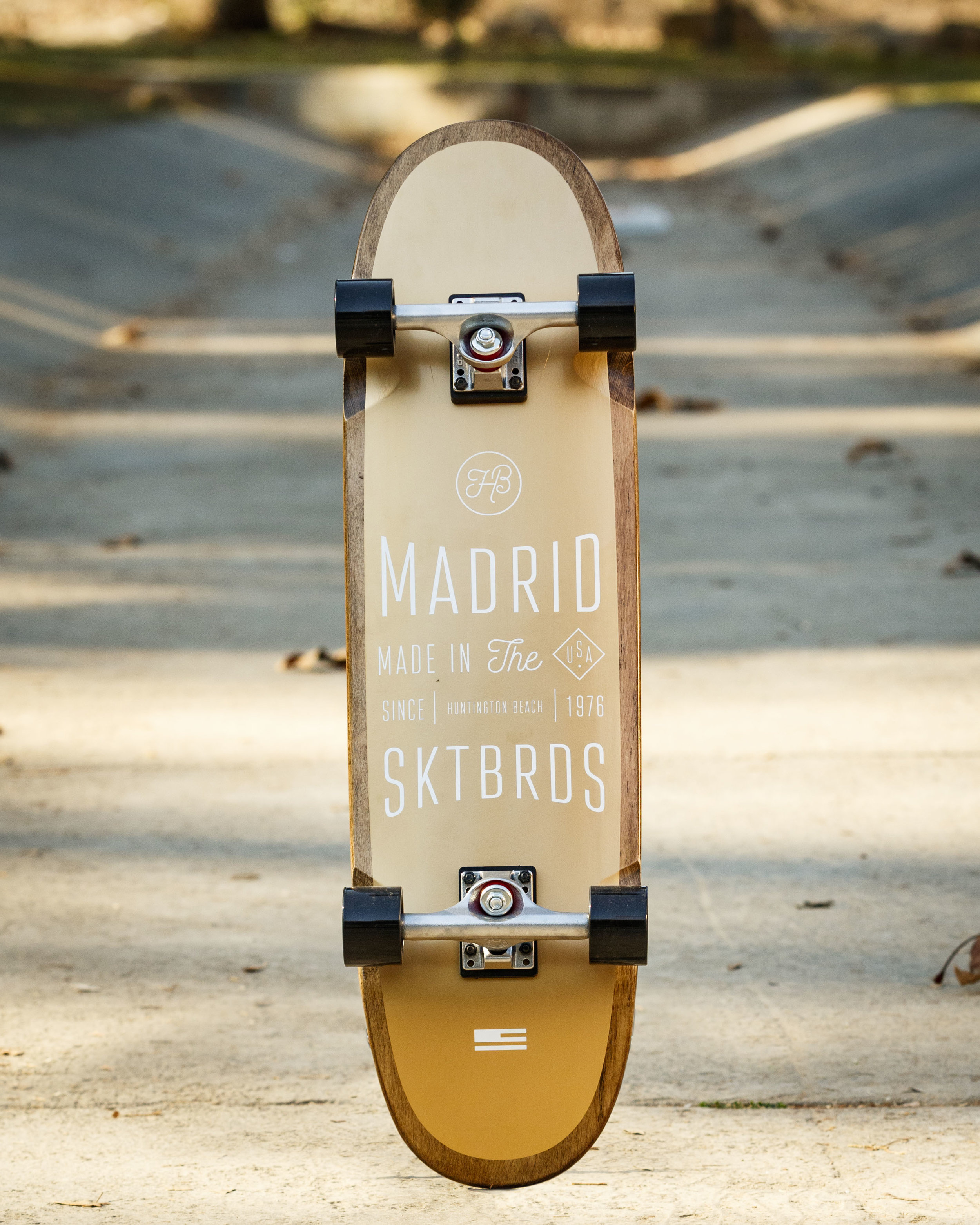
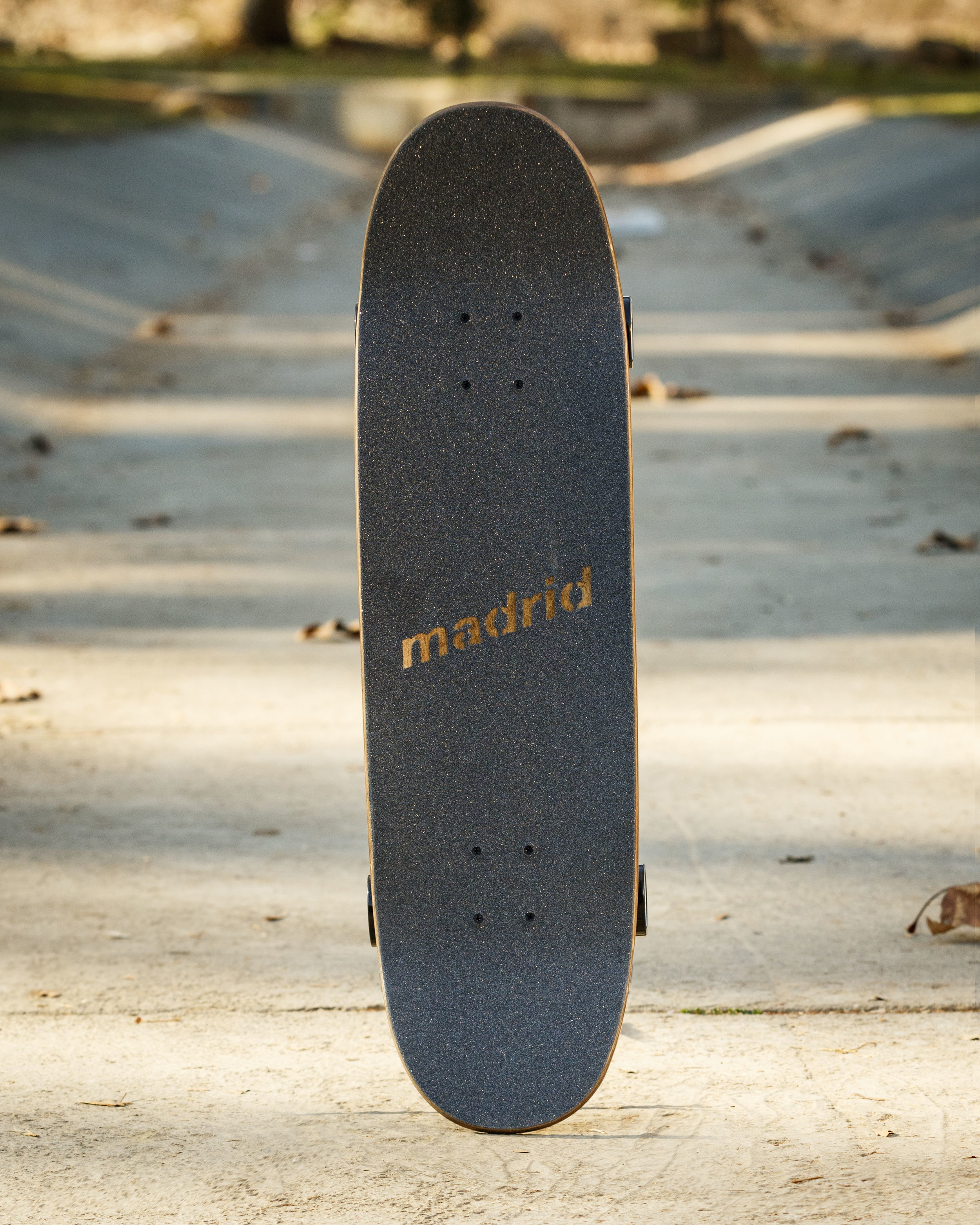
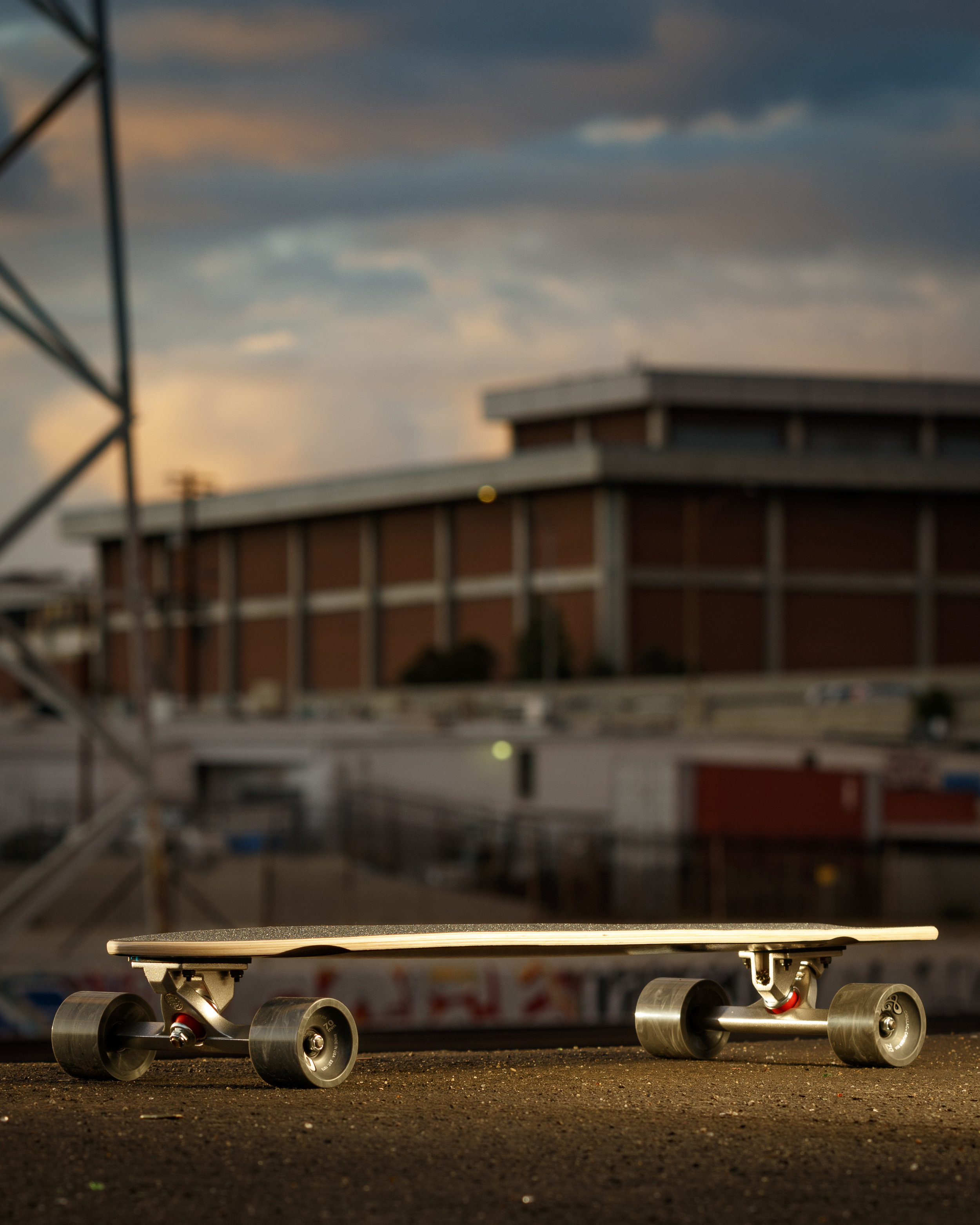
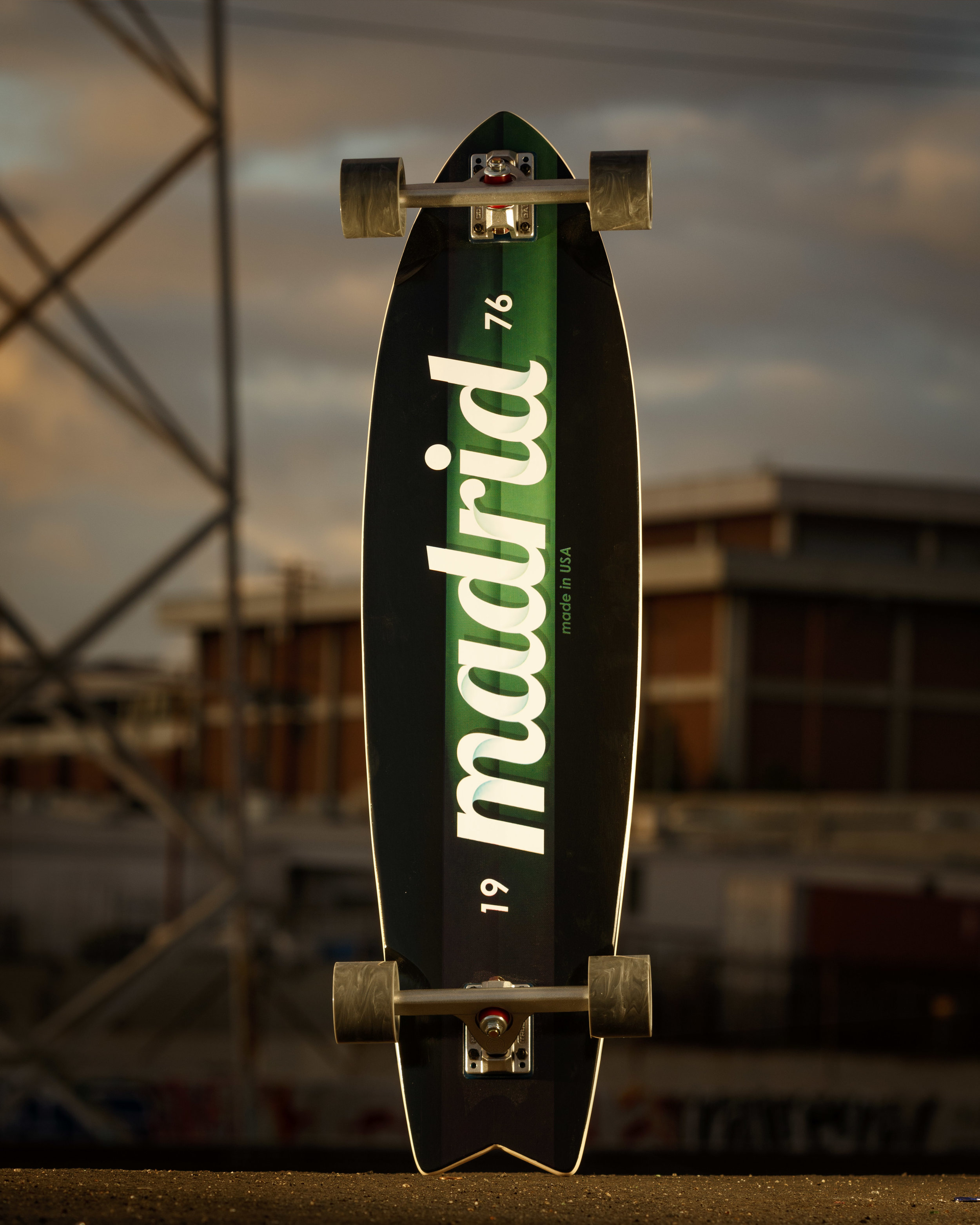
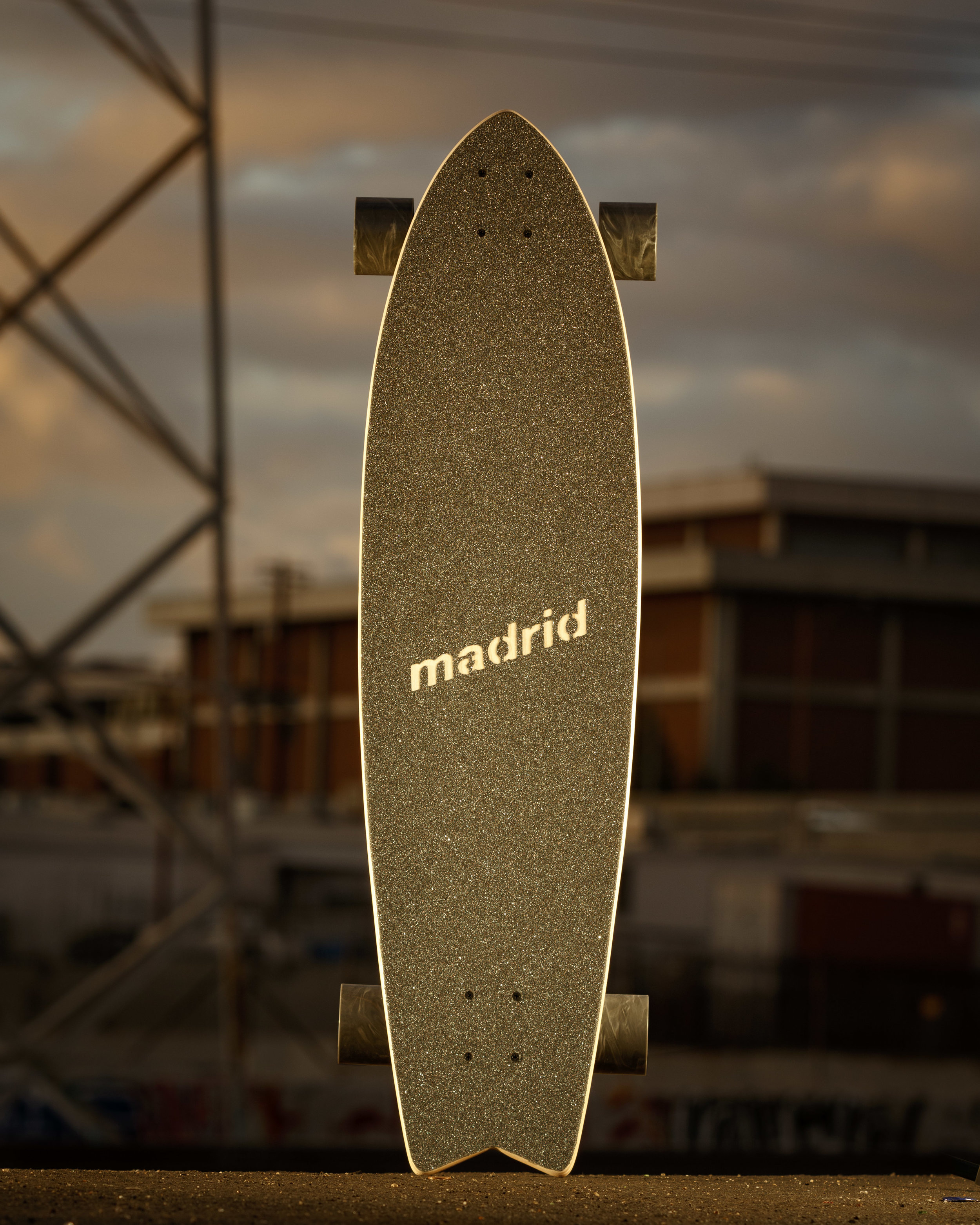
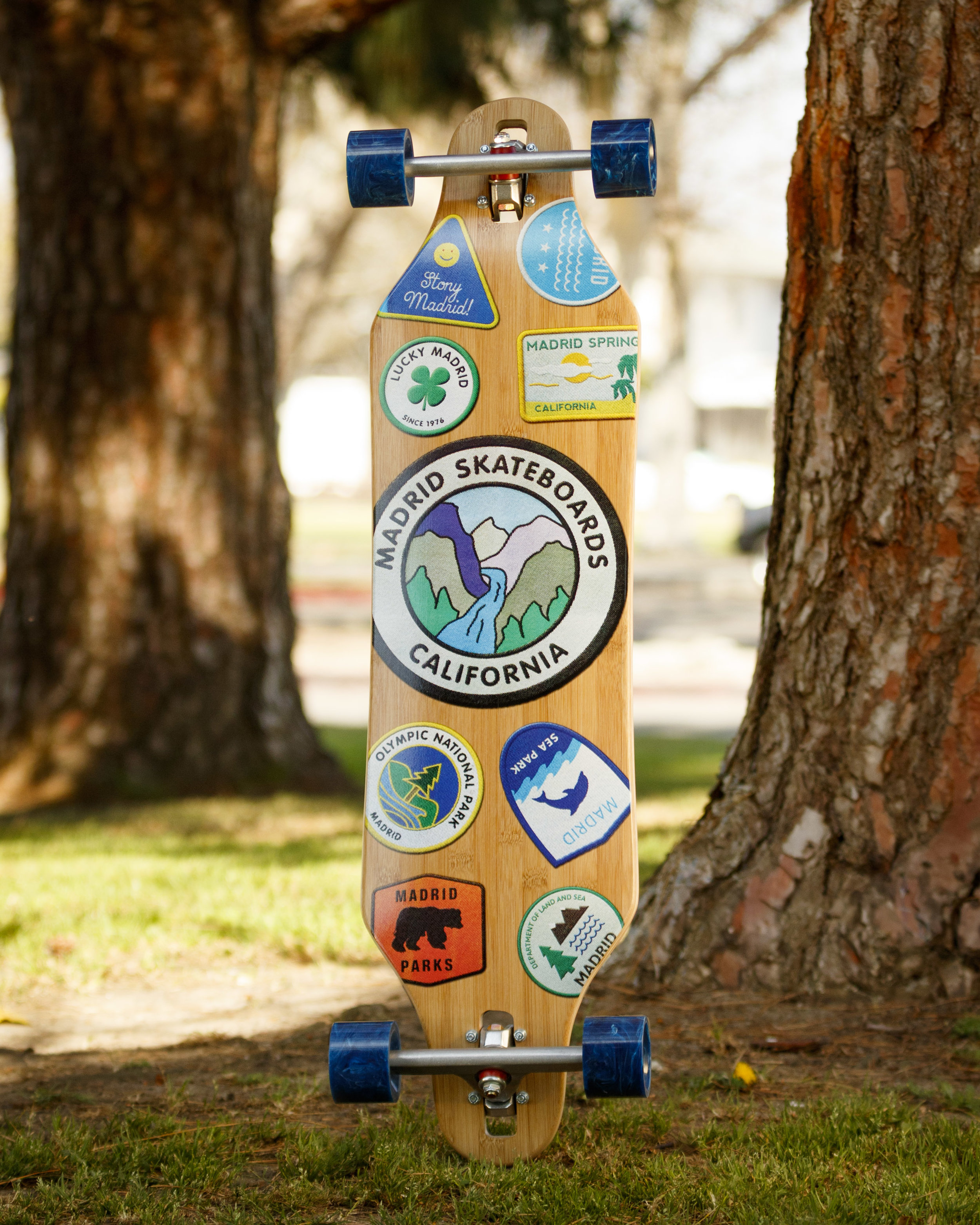
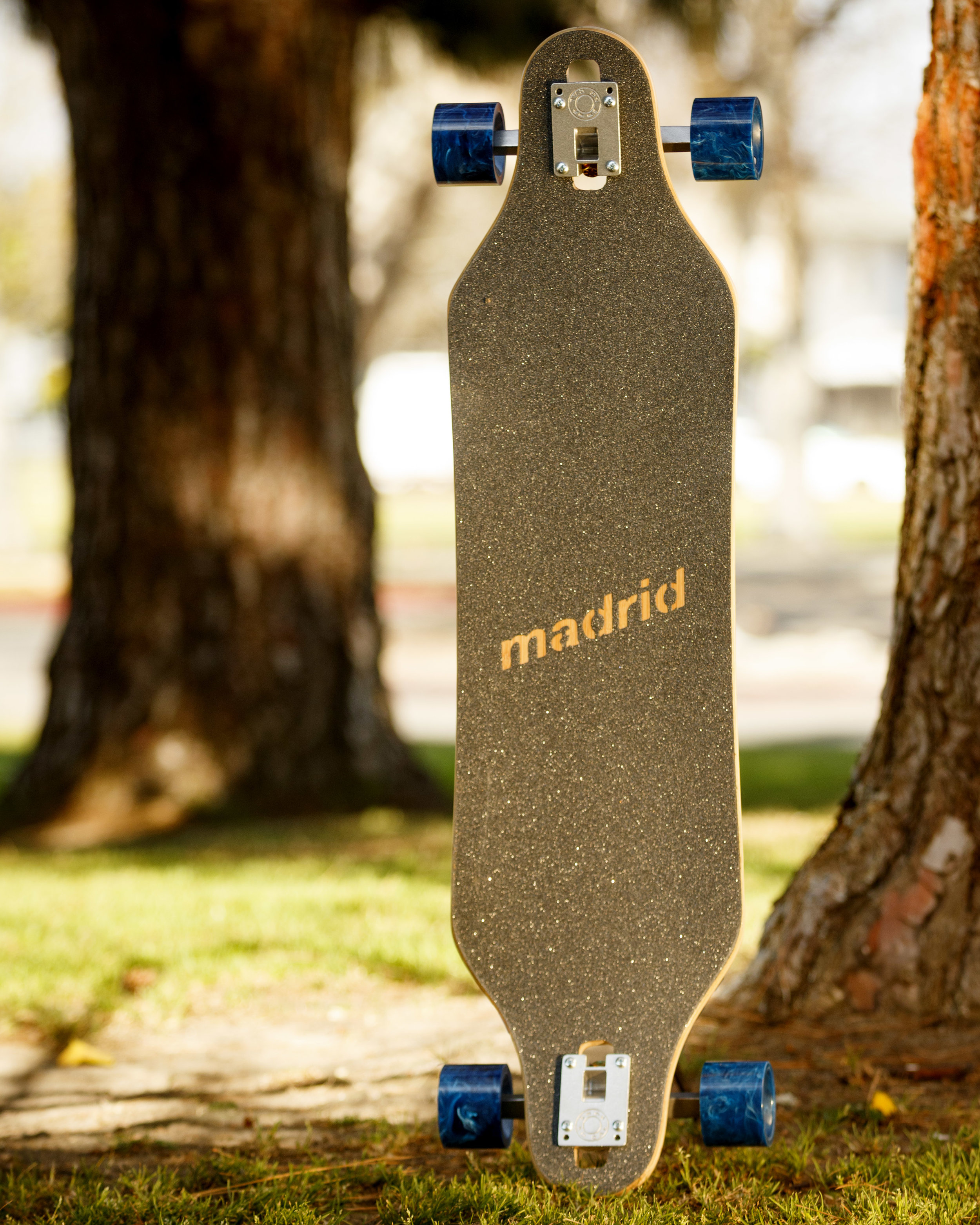
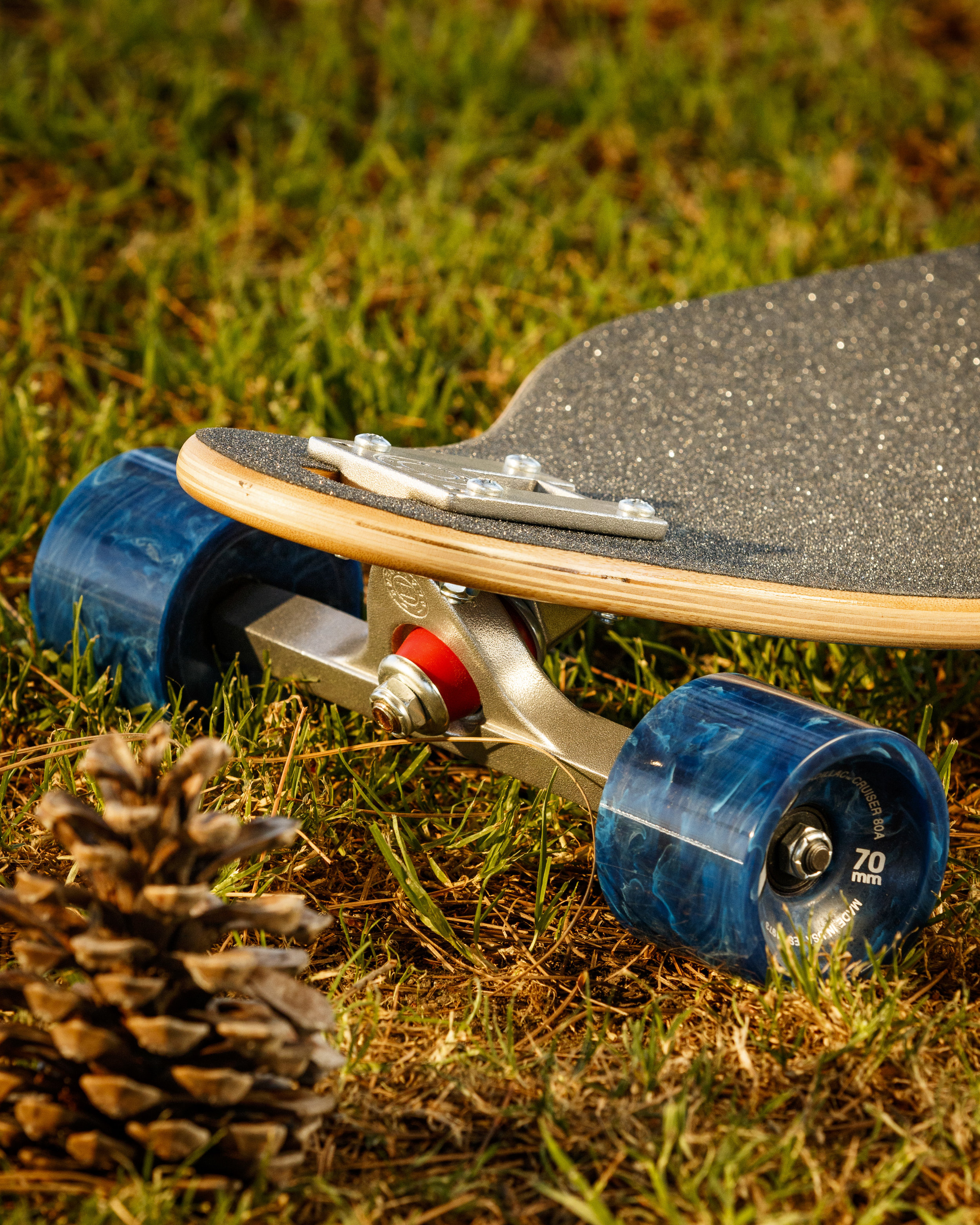
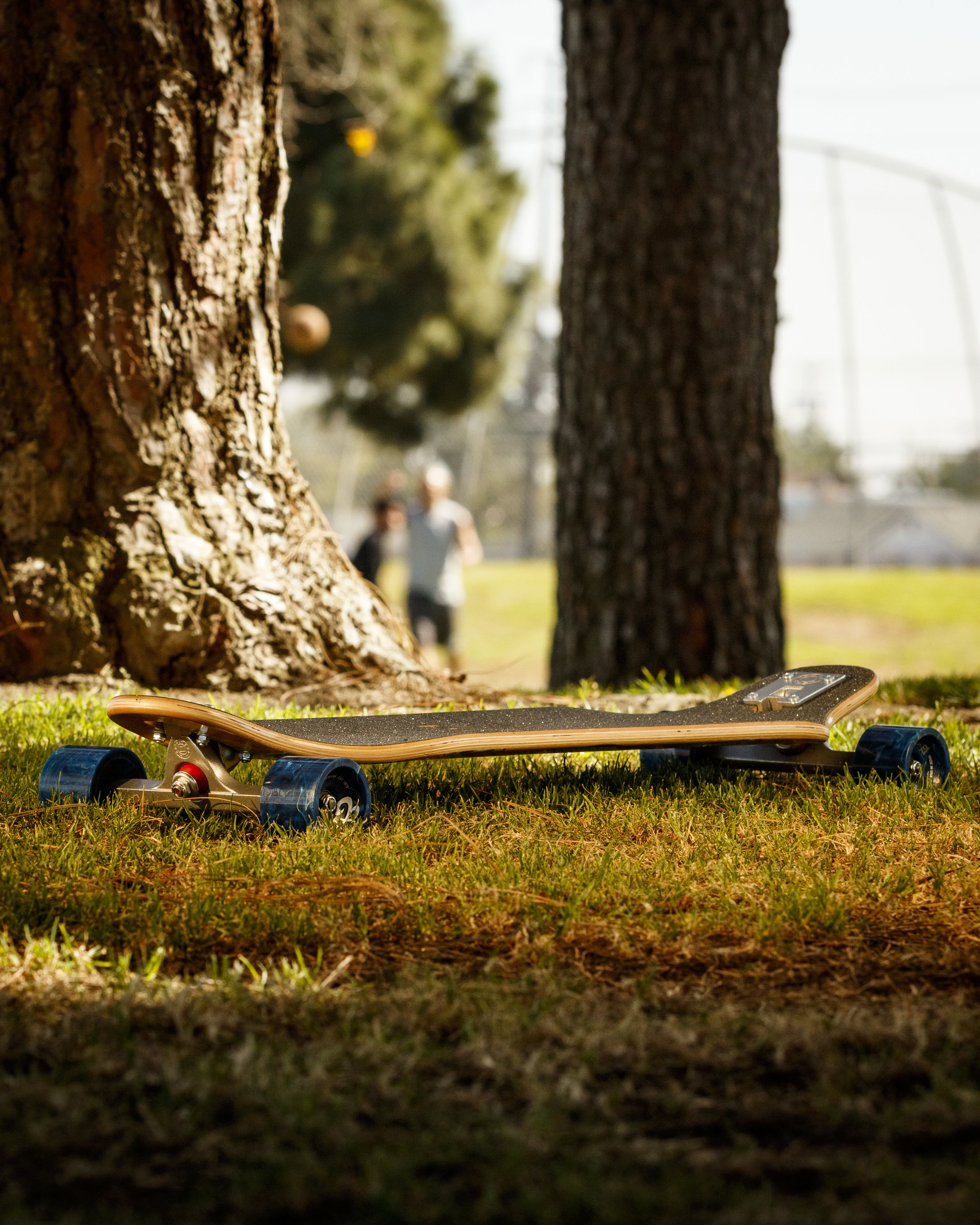
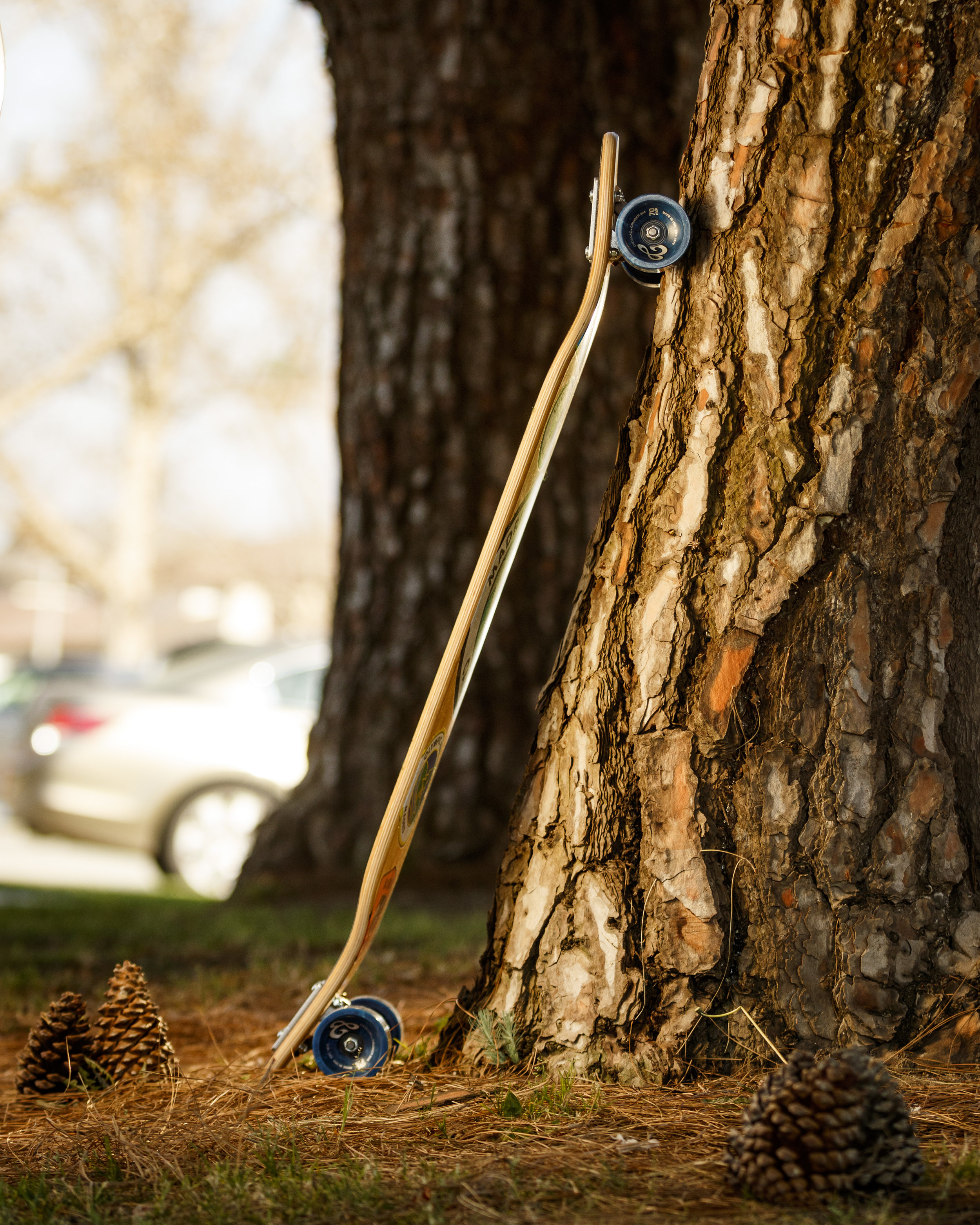
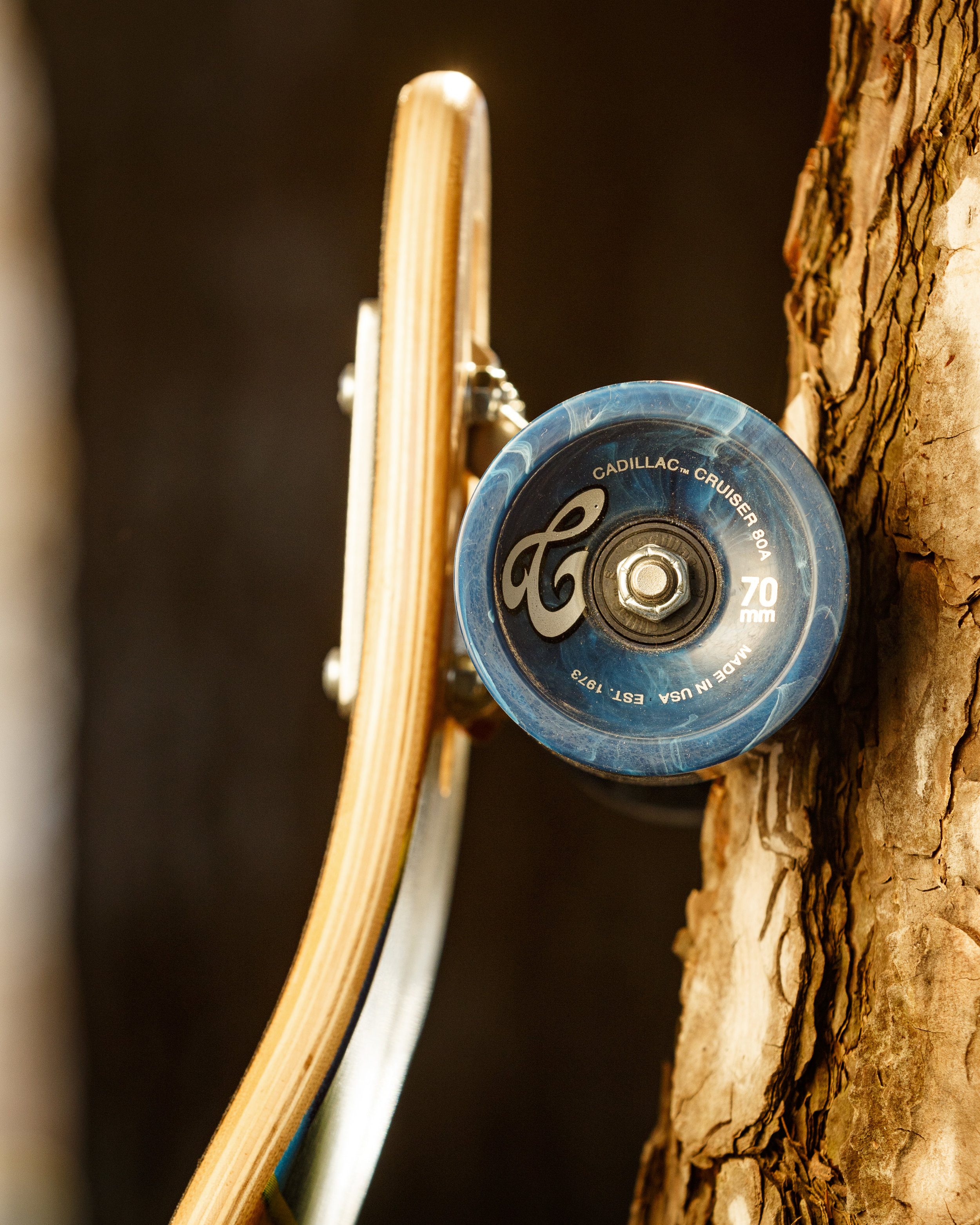
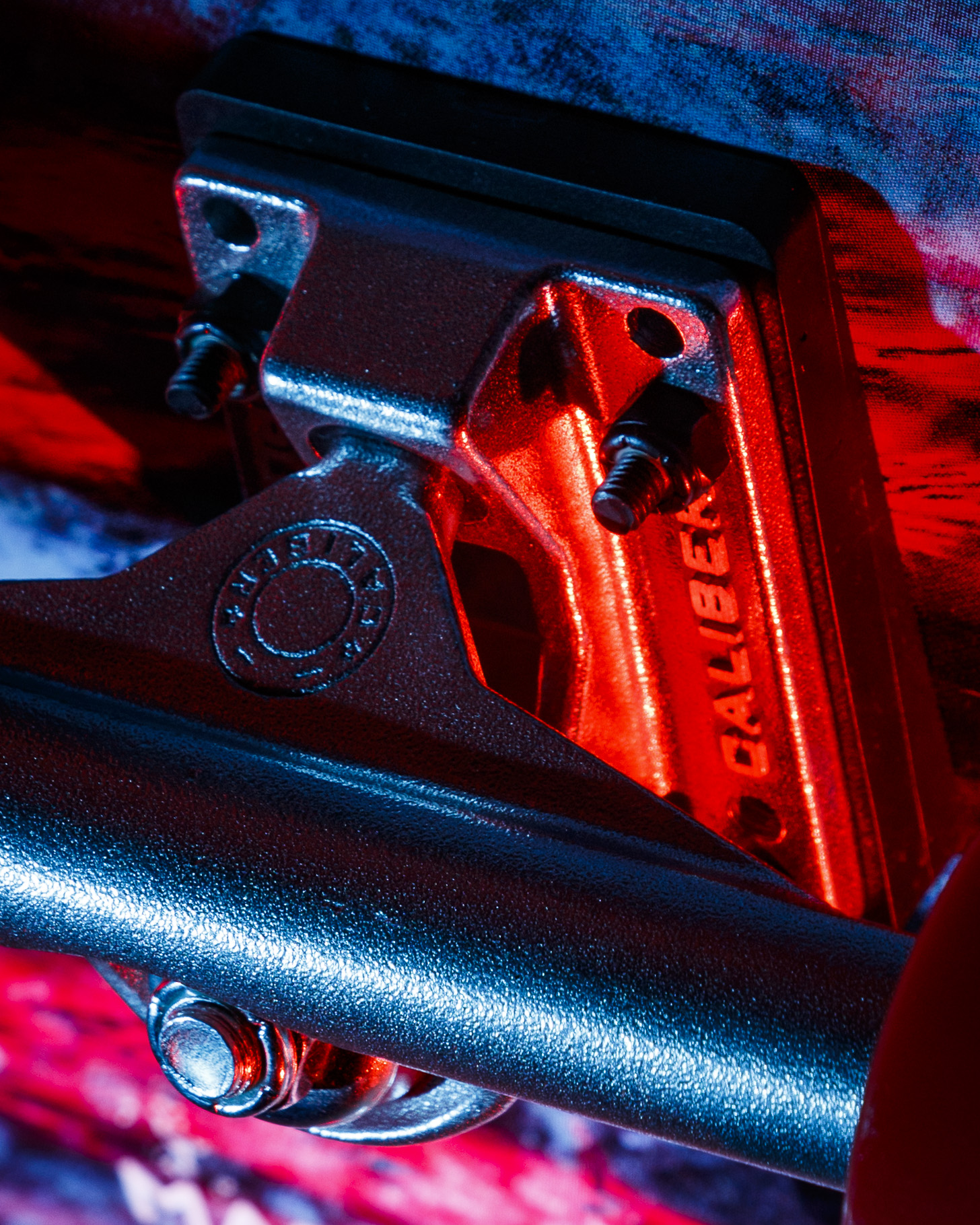
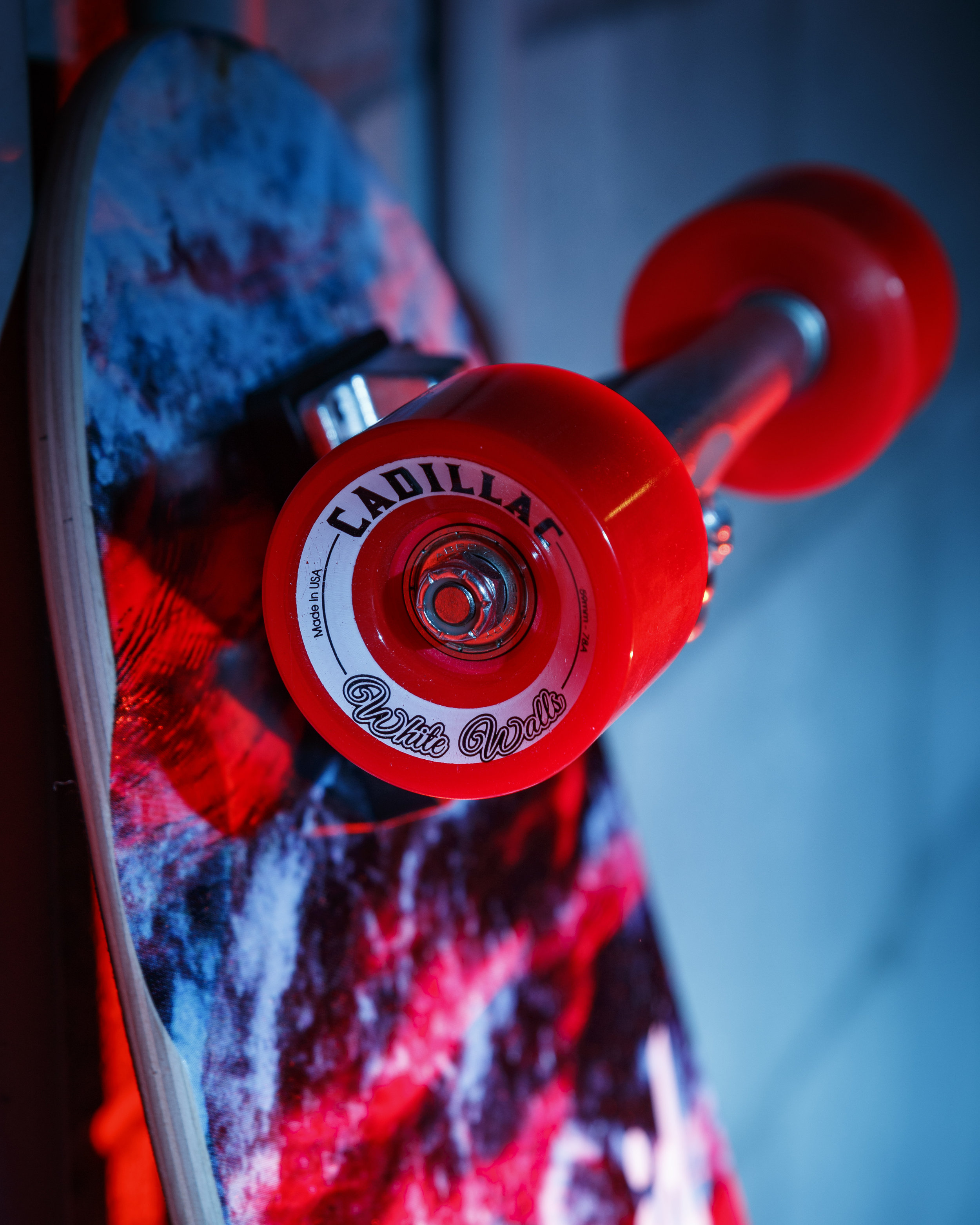
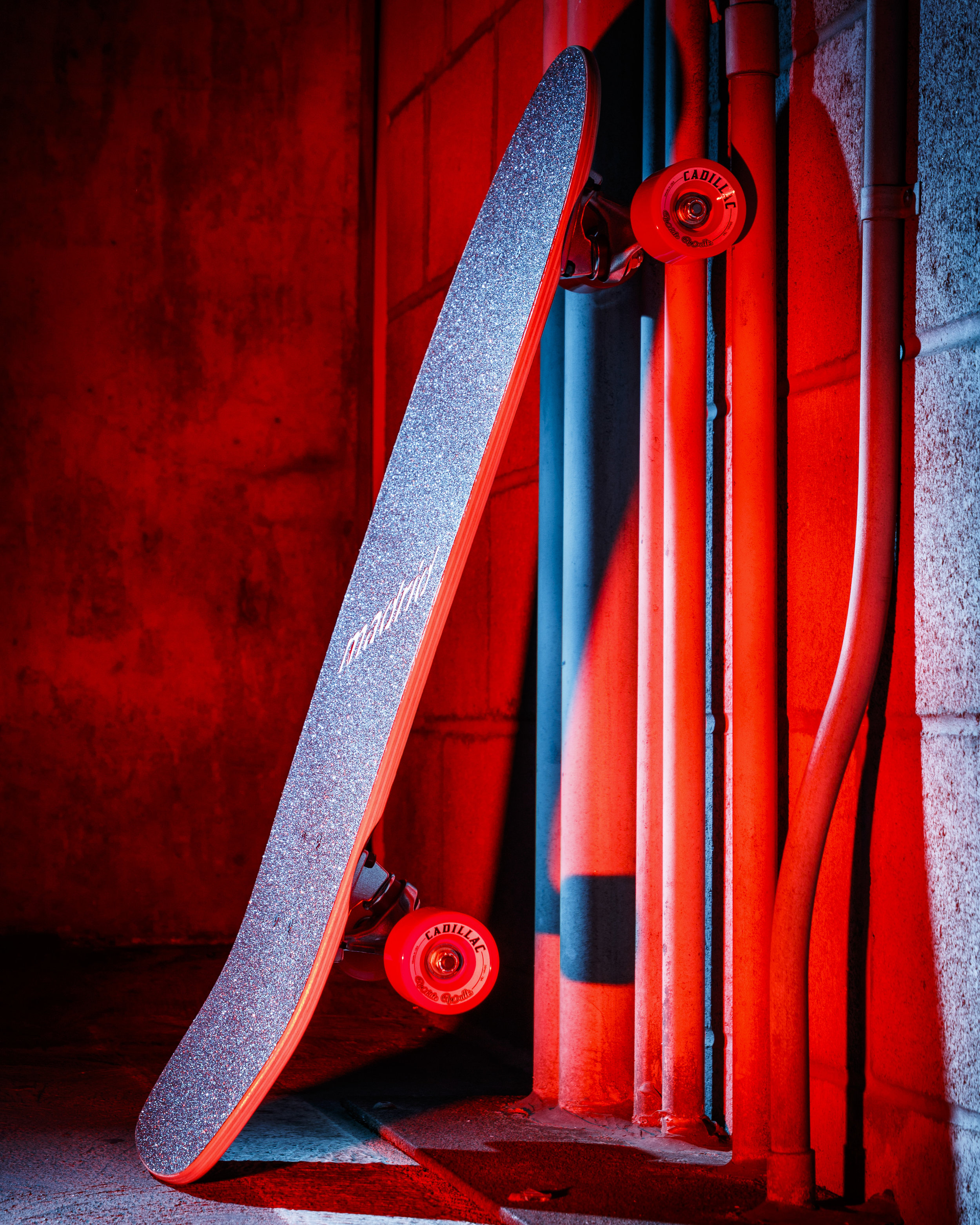
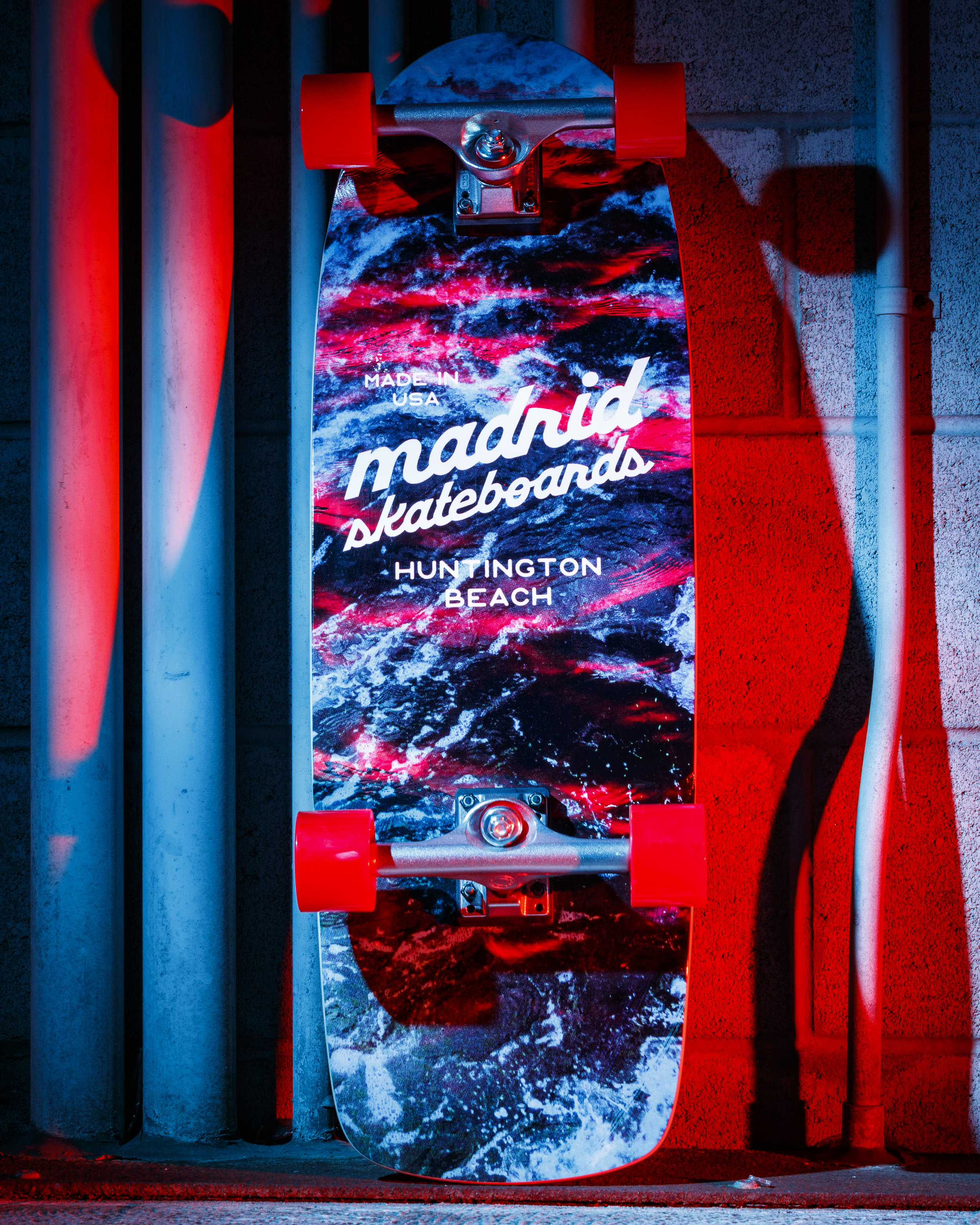
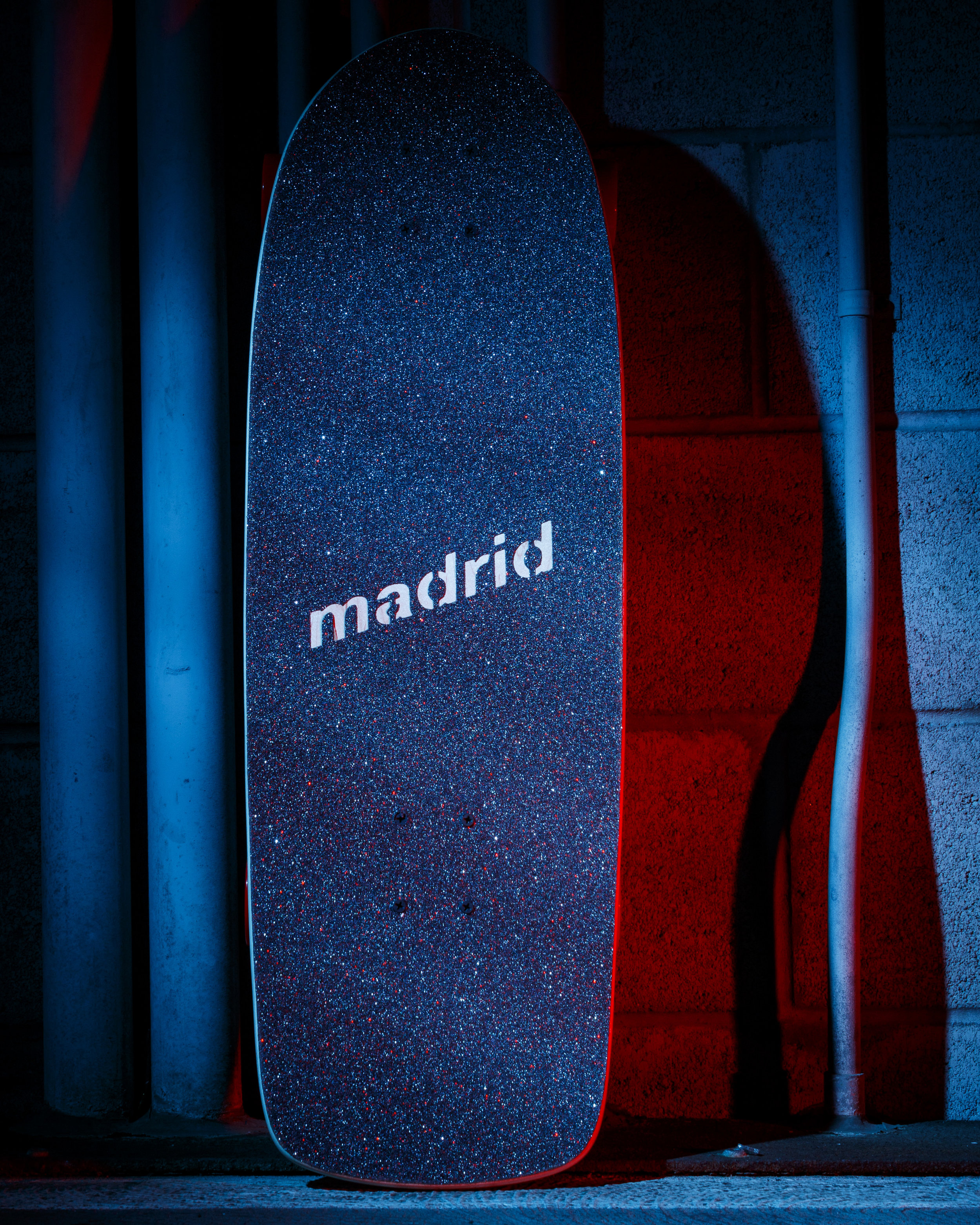
The rollout of swipeable albums on Instagram created new opportunities for showing off the fine details of Madrid's complete skateboards; so I created several mini-albums of creative product shots that highlight the quality components that separate Madrid boards from lower-end brands. You can see them in their original Instagram presentation by checking out the #madridproductalbum hashtag.
The electric skateboard company Acton needed some social-media photos of their Blink S hub-motor mini cruiser, so I took one down to the LA river and did a photo shoot overlooking downtown. Balancing the ambient light with the onboard lights while showing the deck concave was an interesting challenge; but I got it done with some compositing and creative lighting.
0-15mph - putting
10-25mph - cruising
20-35mph - moving
30-45mph - hauling
40-50mph - steaming
50-60mph - blasting
60-70mph - screaming
Over 70mph - nuking
Skateboarding, like everything else worth doing, comes with certain risks. The danger of injury is part of what makes skating so rewarding.
The downhill skateboarding community is generally very conscientious about the use safety gear: everyone wears helmets and slide gloves; many of us wear full-faces, knee pads, and back protectors; and the dudes who skate at very high speed usually do so in armored leather suits. This, combined with not skating like total idiots, does a pretty good job of preventing most injuries.
That said, if you skate long enough you will eventually fall hard and need to go to the hospital to get patched up. Fortunately, modern medicine is pretty good at fixing the bone and joint injuries many of us wind up with and road rash isn’t a serious issue because the antibiotic apocalypse hasn’t arrived quite yet, so you’re probably gonna be fine.
The main thing most American skaters have to worry about is financial ruin: while pretty much every other country has figured out how to provide people with medical treatment at a low cost, America still has an antiquated system of private insurance that can turn a minor tumble off the skateboard into tens of thousands of dollars in debt.
Because of this, it is very important that skaters get health insurance. The good news is that Obamacare is still the law of the land; so if you’re under 26, you can stay on your parents’ insurance and if you’re over 26 and kinda broke, the government will help you pay for coverage. The most important thing to do is sign up within the next two weeks, while the open enrollment period is going. You can sign up or find help with the process at healthcare.gov.
Going to the hospital is the worst way to end a skate session. Don’t let an injury ruin your whole year. Sign up for health insurance.
Sugar Urethane
Midsy Nineballs
Venom Harlot
Vicious Grypp
Xavia Leathers
Kelsii Gordon
Paris Savant
Malibu Chunderpave
Kay Rimes
Polly Urethane
Moonshine Tucker
Cadillac Sugarmama
Glendora Mountainroad
Seismic Hotspot
Sonora Pass
Volante Serrata
Tammy Faye Prader
Rayne Hellcat
Billie Daisycutter Jackal
Mary Hill
(Special thanks to Team Mids for their help with this)
A recent Petapixel article I wrote about my efforts to get paid for my photos has apparently struck a nerve, and several people have urged me to start a Patreon page. Not one to turn down money, I made one and you can find it here.
Also, folks, I decided not to name the company that screwed me over for a reason: when I tagged their company's page in my initial facebook post misguided friends of mine spammed their page with one star reviews. That company has suffered enough damage to its reputation. I have no desire to create a further pile-on.
Since the Petapixel article went up, people have been hitting multiple longboard brands, including Landyachtz Longboards, one of my best clients, with negative reviews. This is not at all helpful. Those guys have hired me many times and always pay me quickly and without hassle. Please stop trashing their reputation on Facebook. If you want to do something to help me out, buy a Landyachtz or Madrid board and tell them I sent you.

Marshal Parrish hitting the one-slide line at Fortress.
I was out skating and shooting in North Carolina for the whole month of April. Staying mostly in Boone, I got to know the locals and the spots in much greater depth than on previous trips.

Tyler Hunt is a beast. I watched him slam hard trying this 50mph stand up slide, then bounce up and go full speed into it next run.

I was there in the very early spring, when the mountain tops were still getting snow and there were no leaves on the trees yet.

Garrett Gourley is an incredibly talented skateboarder who is always having too much fun.

Austin Pedroni, Dex Manning, and Stephan Vaast. I need to go back and get some runs on this one.

This corner is extremely strange. It's steep on the entrance, then flattens out and goes uphill and super off-camber at the exit. Madison Crum leading, then Dexter Manning and Garrett Gourley.

Whoops. That's Garrett, Madison, and Dexter.

Miles Cordier at Surf Spot. Love that road.

Philip Skaar on-sight at last light.
While no amount of high-end gear will make you good at skating without practice and experience, a well-functioning setup will help good riders skate better. And just as doing long standup slides on a straight hill doesn't mean you're good at slowing down and taking good lines through corners, being good at skating doesn’t mean you necessarily know how to build a good setup. Selecting parts to create a board that balances turning, grip, and stability is a skill separate from actual skating.
I may not be the fastest racer or the most stylish freeride guy, but thanks to several years of heavy Silverfish use and a little real world experience I’m pretty good at wrenching on boards and making them ride good.
I can say from personal experience and observing my friends’ skating that sleeved flat bushing washers are fucking garbage and nobody should ever use them for freeriding or downhill.
Allow me to explain. We'll start with the basics of how bushing washers affect skateboard turning.
Flat washers allow for ample deformation of the bushing, enabling deep lean and turning. This is very useful for getting short bushing trucks like Paris, Caliber, and Aeras to turn deeply.
Cupped washers restrict the bushing’s ability to deform, creating additional resistance as you lean farther and the bushing binds in the cup, eventually creating a sort of stopping point at which the truck will not turn any more. This aids stability and can be useful in preventing wheelbite. (Cup washers are also crucial for tuning tall bushing trucks, but that’s another discussion.)
Sleeved washers don't restrict turning like cup washers or allow for ample bushing deformation like flat washers. Instead, they allow for deep turning and increase rebound as you lean, giving your skateboard a snappier return to center. This is good for when you want a lively, bouncy turning response or when you’re riding low-rebound bushings. It is really really bad for downhill and freeriding.
To have any kind of stability, a downhill board needs to be able to lean over and stay leaned over. Too much rebound in your bushing/washer setup will make your board want to dig in and Michael Jackson-style high side on stand up sides, wobble out of predrifts, and throw you off your line through gripping corners. These are not performance characteristics that I find helpful when I am trying to stay in my lane and on my skateboard at 40mph.
Now, you may be saying to yourself “but Dubler, I have these washers in my board and I can skate downhill just fine” or "I like riding a squirrelly and unstable setup because it's more exciting." That may be so, but you would skate better and more confidently if you weren’t battling a poorly-designed setup so shut your dumb mouth and switch your sleeved washers out for normal ones. You will almost certainly notice improved stability, easier cornering, smoother sliding, and less twitchiness.
(And while I'm hating on these things, let's get one thing straight: machined sleeve washers do not make your trucks "more precise" in any meaningful way, and they certainly won't make your cheap Chinese cruiser trucks ride like high-performance racing trucks. A precise truck has perfectly straight axles with machined hangar shoulders, precision-machined pivots with tight pivot cups, and precision-machined bushing seats. Bushing-on-kingpin slop is not really a thing. If you want to make your cast trucks perform better, invest in urethane pivot cups and good bushings, preferably Venom because they are the best and they give me money.)
TLDR: sleeved bushing washers are fucking terrible for downhill and freeriding and you should not use them.

I just got back from shooting Tannie Low and Molly Cuny's wedding in San Antonio. The shoot went very smoothly and I was unexpectedly moved by the sheer, overwhelming joy on the faces of the couple and their families.

Matt Kienzle demonstrates what not to do when you catch up to a car in this 2010 photo.
A fairly exhaustive guide on how to skateboard down open roads relatively safely, the product of many years of experience and far too many near-misses. Read the whole thing on Skatehousemedia.com.
2020 Update: Skatehouse is no longer online, so here is the original text.
This really long post was written by Max Dubler and does not necessarily represent the opinion of SkateHouseMedia or its sponsors.
HOW TO SKATE OPEN ROADS AND NOT DIE
A guide to best practices by Max Dubler
PREAMBLE - Safety is a constant topic of discussion in downhill skateboarding. We all know that downhill skateboarding can be very dangerous and all of us have had our share of sketchy moments over the years, most of which we walk away from a little scraped up and a lot wiser.
Those of us who’ve been doing it for a long time and have a deep well of experience and knowledge about how to skate safely often find ourselves shaking our heads at the latest videos of people doing stupid things on the road, then taking to social media to condemn inexperienced riders for their poor judgment.
Instead of complaining about people’s sketchy riding, I want to share what I’ve learned in my years of downhill skateboarding with the community. This is my attempt to spell out the best way to skate open roads and minimize your chances of death or serious injury.
Skateboarding in general is never going to be totally safe, but downhill is especially dangerous. Unlike street and transition, which take place in relatively controlled environments, downhill is, by necessity, practiced mostly on open roads where there are environmental factors beyond a skater’s control. This unpredictability, combined with the inherent danger of high speeds, makes downhill skateboarding a much higher-risk activity than “regular” skateboarding: nearly everyone who died skateboarding in the last few years was hit by a car or fell and hit their head while longboarding.
Every time you kick into a mountain run, you are risking death or serious injury. Last year I went off the road at 40mph and bounced off a tree, avoiding serious injury only because I happened to be wearing leathers with a built-in spine protector. My friend’s ex-girlfriend went wide on a right-hand turn, hit a car and died. Another friend hit a mailbox post and was paralyzed. A third friend slid out on some gravel, hit a guardrail upright and broke his spine. If you’re going to skate mountain roads, you need to be serious about safety.
So, without further ado, here’s how to skate downhill and not die.
WEAR SAFETY GEAR - Protective gear is the starting point for any discussion of skateboard safety. I’m assuming that if you’re reading this, you wear, at minimum, a full-face helmet and slide gloves when you skate downhill.
Helmets are the most important piece of safety gear. A good hard-foam helmet will protect your brain and keep you from dying if you hit your head.
Soft foam might be more comfortable to wear, but it won’t actually protect your brain in the event of a bad hit. You need a hard-foam helmet, preferably EPS foam.
Hard foam helmets are good for one hit only. If you smash your dome, it’s time for a new lid.
The chin strap needs to be snug to prevent your helmet from flying off during a crash. I strongly recommend D ring closures over plastic clips.
If you can, go to a shop and try on helmets in person to find the best fit. Helmet manufacturers all use different molds and different brands fit different head shapes. I have a more oblong head, so Pro-Tec half shells fit me well. If you have a rounder head, Triple 8 will fit you well. If you’re in between, check out S-One.
I am not a particularly attractive man to begin with and smashing my face on the ground wouldn’t help anything, so I ride a full face helmet when I skate downhill. (The face shield also keeps me from getting hit in the face with rocks and prevents bugs from flying into my mouth, which is exactly as gross as it sounds.)
There are several skate-specific full face helmets to choose from. Personally, I ride a TSG because I like the design, it fits me well, and it has a good visor system.
If you’re on a budget or want extra protection, downhill mountain bike helmets are great for downhill skateboarding. They’re usually bulkier and less aerodynamic than dedicated skate helmets, but the extra foam thickness makes them safer and the vents keep you cooler on hot days. It’s pretty easy to add a face shield yourself.
Gloves are the second-most important piece of safety gear, mostly because they allow you to ride with control and avoid crashing in the first place.
All commercial slide gloves are pretty good. Leather is more durable and will protect your hands better. Textile is cooler and more breathable.
A good beveled edge will keep your slide pucks from catching on cracks in the road.
I would like to see spine protectors join helmets and gloves as standard safety equipment, as your spinal cord is just as delicate and essential to your well-being as your brain.
Knee pads are always a good call.
If you’re wearing street clothes or picking out leathers, bright colors will help you be seen by motorists and pedestrians.
For maximum protection, skate-specific NJK leathers with full pads and a spine protector can’t be beat. There’s a reason all the top pro riders are willing to pay full price for NJKs: they are far and away the best designed, most durable, easiest to ride in leathers for downhill skateboarding. Don’t waste your money on any other brands. You’re better off with off-the-rack NJKs than custom off-brand leathers. 2020 Update: NJKs are still good, but the off-brand suits are almost as good at ⅓ the price.
All that said, safety gear is your last line of defense. The best way to stay safe is to avoid crashing in the first place and to avoid uncontrolled crashes at all costs.
UNCONTROLLED CRASHES: THE WORST CASE SCENARIO Uncontrolled crashes that lead to collisions with fixed, immovable objects are the most dangerous thing about downhill skateboarding. To avoid this kind of crash, you need to (a) avoid hitting or getting hit by a car, and (b) stay on the road and in your lane at all times, preferably while on your skateboard.
SITUATIONAL AWARENESS, SKATING COMPETENCE, AND RISK MANAGEMENT are the keys to avoiding uncontrolled crashes. I will attempt to lay out best practices here.
SKATING COMPETENCE - This guide presumes that you know how to control yourself on your skateboard at speed. You should know how to predrift both ways to slow down for corners, footbrake at speed, and maintain your lane all the way through any corner. If you do not yet possess these skills, session corners to work on them before you try to go bomb down mountain roads.
Author’s note: long standup slides on a straight hill do not necessarily prepare you for real downhill riding. Make sure you know how to slow down and take a line, not just slide far.
This also presumes that your gear is appropriate for high-speed riding and in good working order. You need wheels that grip, a full set of mounting hardware, trucks and bushings that are stable at speed, and bearings that aren’t going to explode from neglect.
RISK MANAGEMENT AND SITUATIONAL AWARENESS - Learning how to control a skateboard is relatively straightforward. Learning how to evaluate the potential hazards on a given road, adjust your skateboarding to prepare for the worst-case scenario and skate safely is much more nuanced and difficult.
WHEN TO SKATE - Ideally, you want to skate at times with the least traffic, usually very early mornings at first light (dawn patrol) or during the day on weekdays. Avoid skating during busy times, usually rush hours and weekend daytimes. Individual roads might have peculiar busy times, so it’s worth doing all the research you can.
EVALUATING THE HILL - When you arrive at a road you’re planning to skate, drive up from the bottom and have the person in the passenger seat check for gravel, wet pavement, and other debris in the road. If you see any potentially hazardous gravel or rocks, pull over and kick them out of the road.
Note the location of driveways, intersections, parked cars, pull-outs and other places where you might encounter a car and approach these sections of road with the knowledge that you may have to stop suddenly.
SKATING CONSERVATIVELY - More than anything else, your frame of mind informs the safety of your skateboarding. You want to skate conservatively and always be prepared for the worst case scenario.
If you approach your open-road downhill skating with a “fuck it, I’m just going to go for it 100%, not think about the consequences, roll the dice and hope it works out” mindset, you are going to get hurt or killed. This mindset, which is somewhat useful on closed roads and when you’re skating street or transition, is bad for downhill because the consequences of an uncontrolled crash at high speed are much worse than the potential consequences of slamming at the skatepark or hitting hay at a race. In practice, this mindset is what motivates people to take stupid risks like going into the uphill lane on blind corners.
On the other hand, if you approach your skating with the knowledge that the road will be there tomorrow and that there’s a time and place to push it, you will skate more conservatively and be much less likely to find yourself in a bad situation.
In practice, skating conservatively means chilling out, recognizing the difference between the fast line and the safe line, maintaining your lane at all times, and being ready for spots where you might encounter an unexpected car.
Chill out. There’s no need to go full bore 100% edge-of-control fast on open roads. Slow it down a little and keep it together so you don’t crash. You can go balls-out at events with closed roads and safety precautions.
Recognize the difference between the fast line and the safe line. There’s famous downhill road in Santa Barbara with two very steep right-hand hairpins that uphill vehicles often cut. The fast downhill line is to slide in the uphill lane, dive to the middle of the downhill lane, then fade wide. The safe line is to slide almost to a stop on the inside of the downhill lane, grip up at the apex and hug the edge of the road all the way through, then roll out at running speed.
If you want to take the fast, dangerous line, use spotters. (More on this later.)
Maintain your lane at all times. There is no going into the oncoming lane unless you have a clear view of oncoming traffic, and even then it’s a bad idea. On narrow or undivided roads, stay far over to your side.
Be ready to encounter cars. Most people drive like idiots. Don’t trust drivers to stay in their lane or look both ways before pulling out into the road. It’s better to go a little slower and hug your side of the road than to bounce off a car that was in 2’ in your lane.
Reaction time and physical coordination is critical. Don’t skate downhill when you’re drunk or high.
You need to be able to see and hear what’s going on around you. Protect your eyes with sunglasses or a face shield and don’t ride with headphones.
Be ok with not skating. You’re going to encounter situations where it’s impossible to skate with any reasonable degree of safety. It is ok to say “this is fucked, I’m not down, let’s go to the next spot” or “this traffic is crazy, let’s come back tomorrow at dawn” or “I’m just gonna drive at this spot.”
SLIDE EARLY FOR CORNERS - It’s better to slide early, grip up early and pick up speed as you roll through a corner than to slide too late and go off the road. Sliding early also gives you the time and space to slide more and adjust your line or, if you don’t make it, slide to a stop in a controlled manner, rather than going off the road.
THE IMPORTANCE OF FOOTBRAKING - Footbraking is important for three reasons. First, the overwhelming majority of people have never seen downhill skateboarding and do not know how to read a skater’s body language. When a driver unfamiliar with downhill skateboarding sees you crouching down and putting your hand on the ground, they don’t see someone about to slide the wheels across the pavement to slow down in a controlled manner and skate safely through a corner, they see someone about to crash. Everyone intuitively understands that dragging your foot along the pavement will slow you down.
Second, footbraking allows you to slow down gradually and in a straight line, making it extremely useful for pack riding and dealing with cars. Coming up on your friend into a tricky corner with only one line? Drop a little footbrake to put a little distance between you. Unexpected car? Footbrake to the side of the road.
Third, footbraking is actually a great way to slow down. Once you get the hang of it, footbraking will slow you down just as quickly as sliding.
DEALING WITH CARS - The overwhelming majority of people driving cars have never seen downhill skateboarding and are freaked out by the sight of kids on longboards whizzing past them at 40mph on a narrow mountain road. This is a completely rational response to what we do. I still get nervous when I encounter unexpected skaters on the road.
The best way to deal with cars is to avoid them completely. Pick a low-traffic time to session. When it’s time to drop in, wait for a long gap in downhill traffic.
If you catch up to a car driving downhill, slow down or stop. You don’t know if and when they’re going to jam on the brakes and you don’t want to slam into the back of an immovable object. Passing cars is dangerous and not that cool (they can always step on the gas and leave you in the dust). Waiting a couple minutes to finish the run is not that big of a deal. The pavement is not going anywhere.
If a car catches up to you, footbrake to the right-hand side of the road* as soon as possible and let them pass. (At the bottom of the run, yell at the shuttle driver for allowing a car to pass.)
*Not applicable in left-hand traffic countries.
USING SPOTTERS is a great way to go fast relatively safely on an open road. A spotter is someone who hangs out on a corner, watches for oncoming cars and uses arm signals or flags to tell skaters whether or not the corner is clear.
If you’re spotting, keep your attention focused on uphill traffic. You are not there to watch your friends skate. You are there to keep your friends from getting hit by a car.
Stand where skaters can see you and you can see oncoming traffic.
If no car is coming, signal a clear corner by waving your whole arm in a circular motion or using a green flag until all skaters have passed through the corner.
If a car is coming, hold one arm above your head, palm out or wave a yellow flag.
If a big truck is coming or the road is impassable around the corner and skaters need to stop, hold your arms in an X over your head or wave a red flag.
THE SHUTTLE/CHASE CAR
When it’s your turn to drive a run, you have two jobs: first, you’re the sweeper. You make sure everyone gets down ok and pick up anyone who, for whatever reason, cannot or does not want to skate all the way down the run. If someone crashes, you make sure they’re ok and pick them up if they aren’t.
Second, and most importantly, you are the shield that protects skaters from downhill traffic. No matter how closely you’re being tailgated, you do not ever pull over to allow cars to pass. Should someone pass you in spite of your efforts, you should make every effort to inform the skaters by honking the horn.
RIDING IN GROUPS- Given the capacity of most passenger vehicles, you’ll almost always be dropping into a hill with at least 2-5 other riders. Nobody wants to get crashed out by another rider doing something dumb, so some etiquette is in order.
Open road riding is not a race; the goal is to make it down and have a good time, not beat your friends to the bottom. Ain’t nothing wrong with chilling in back.
Be aware of other riders around you. If you’re coming up behind someone, clap or give them a touch to let them know you’re there.
Don’t kick in first if you’re the slowest rider. You don’t want everyone passing you or struggling to stay behind.
If you’re thinking about making a pass, make sure you’re going to be able to stay in front: don’t do that make-the-pass-and-immediately-airbrake thing.
If you’re going to bump someone, be gentle and make sure they’re ready for it.
Once again, the key here is to chill. There’s a time and a place to rage. You can get your fill of insane pack riding at at Maryhill Freeride. There’s no need to go three wide through blind corners on open roads.
WHEN SOMEONE CRASHES You can do everything right and still crash due to factors beyond your control. I am not qualified to give medical advice, but I urge all skaters who ride downhill to get trained in first aid and keep a first aid kit in their car.
In the event of a bad crash resulting in serious injury, the very first thing you should do is call 911 and tell them the truth about what happened so they can tell you want to do and send professional help. Your friend’s health and safety is more important than your skate spot.
CONCLUSION: Downhill skateboarding inherently dangerous, but it’s a lot less dangerous if you respect the road and make smart decisions about when, where, and how you skate. Being aware of your surroundings, recognizing and managing risk, and skating conservatively will allow you to skate downhill as safely as possible.
A version of this essay originally appeared on Jenkemmag.com
I am thirty years old. I have been skateboarding since I was eleven and realized I was gay when I was twelve or thirteen.
As a suburban kid in Rhode Island, I was attracted to skateboarding because it is so unlike organized sports. There are no rules, uniforms, or coaches telling you what to do. Skateboarding’s welcomes arty misfits like myself who are more interested in doing something creative than competitive.
I came out when I was seventeen, a few months before president Bush went on television to endorse a constitutional amendment to ban gay marriage. I had the best parents a gay kid could’ve hoped for and I don’t have any horror stories about homophobic bullying in school.
While I was in college I got more seriously into skating and connected with the downhill scene, which led to getting my first sponsor at twenty two. After graduation, I moved to California to skate and take photos. Longboarding took off right after I got to LA and I have spent the last seven years traveling the world as a photographer and pro longboarder.
As I became known in my little niche of skateboarding, I made a point of being visibly out because there were never any publicly out gay pros when I was a kid. Representation is important: skate media features all kinds of riders--jocks, preps, stoners, drunks, heshers, punks, hip hop heads, pretty boys, people of color, hippies, old dudes, preteens, even severely disabled people--but no out gay people. As a result, your average teenage skater never sees an LGBT person they can relate to and the LGBT kids never see a skateboarder they can identify with.
Now Brian Anderson has decided to be the first professional skateboarder to come out. What BA just did is fucking radical, in every sense. Coming out has always been the most powerful tool for securing LGBT people’s social and legal equality. The appearance of an out gay pro, especially someone widely respected with major sponsorship, opens the door for other skaters to come out, and is an important step toward making skateboarding more accepting of LGBT people.
To be honest, my initial reaction to the news was “It’s 2016 and we have openly gay NBA players and soldiers. What took this dude so long?”
That’s easy for me to say because I’ve had a pretty easy time of the gay thing. BA is 10 years older than me and came of age during a much scarier time for gay people, when homophobia was worse and AIDS was killing gay men by the tens of thousands. More importantly, the skateboard industry has been overtly hostile to LGBT people for decades.
Skateboarding embraces violently homophobic pros. Most skaters have no idea that Jay Adams went to jail for instigating a fatal gay-bashing. Danny Way also had a role in the beating death of a gay man, an incident that sent his friend and fellow pro skater Josh Swindell to jail for 19 years. These incidents go unmentioned in skate media.
There has never been an out gay pro before BA. The closest we have come is with Tim Von Werne, who was forced to stay in the closet when Birdhouse pulled Von Werne’s 1998 Skateboarder interview because he planned to publicly discuss his homosexuality. Another openly gay skater, Jarrett Berry, got the cover of Big Brother’s “gay issue” skating in chaps with his ass hanging out. The tagline was, “Jarrett Berry and other fruits and fairies.” In the eighteen years since, we’ve had no out gay sponsored skaters.
During those same years, there was widespread tolerance of homophobic language. I shed no tears for the death of aggressive inline, but skateboarding had a big hand in harassing it out of fashion by calling rollerbladers faggots for years on end. Recently, skateboarders adapted the joke about “the hardest part of rollerblading” being “telling your parents you’re gay” to hate on longboarders too.
I know you are all about to get in the comments to tell me this is all in the past and say sexuality has nothing to do with skateboarding because nobody cares who you fuck as long as you shred.
Sexuality would have nothing to do with skateboarding if the skate industry wasn’t so heavily identified with male heterosexuality. Sexualized images of women are pervasive in skate media and marketing. There’s a wheel company based on pictures of naked chicks and a board company based on softcore anime porn. Creature has a hot chick calendar. Skateboarding is frequently portrayed as something women watch men do. When we do see women skate, they are sexually objectified and valued for their looks more than their skills. None of this is particularly surprising--the skateboard industry exists to sell shit to teenage boys--but if you’re a gay person or a woman it’s easy to look at all of this and conclude that skateboarding wants nothing to do with you.
Also, skateboarding is heavily identified with toughness and a willingness to endure physical pain. This makes sense: mastering basic skateboard skills requires a tolerance for hitting the ground over and over again. Getting reasonably good requires enduring a long series of bruises, scrapes, and sprains. Doing anything moderately impressive comes with the risk of getting broken off. Thrasher’s Hall of Meat, which celebrates the blood and broken bones that come from reaching the limits of gnarliness, is skateboarding’s ultimate display of hypermasculinity.
Skateboarders often presume gay men and women do not possess this kind of toughness. That’s why your friends will tell you to “stop being a pussy and fucking go for it” when you hesitate on a trick, and why they’ll call you a fag if you back down. When Nyjah said, “Some girls can skate, but I personally believe that skateboarding is not for girls at all,” he was saying he didn’t think women are tough enough to take slams. Calling someone a faggot is akin to calling them weak, cowardly, and feminine.
This is all some sexist, homophobic, jock-mentality bullshit. It cannot go away soon enough.
There is an important distinction to be made between skateboarding, skateboarders, and the skateboard industry. Skateboarding has never given a shit about who I date: I’ve never hung up on a homophobic piece of pool coping or gotten pitched by a pebble that hates fags. The skateboarders I meet are usually cool about the gay thing. Yes, some younger skaters casually use homophobic language out of habit, but I blame that on mental laziness, not intentional malice. When I talk about the skateboard industry, I am talking about professional skateboarders, the companies that sponsor them, and the media outlets that cover them. These businesses exist to sell shit to teenage boys and live in fear of the lost sales that might come from being perceived as being lame or uncool--in the parlance of their customers, “gay.”
Maybe it takes someone like BA—a big, physically-intimidating white dude with untouchable skate credibility and major sponsorship—to change the industry’s mind about sponsoring openly gay people. Personally, I think skateboarders have been ready to embrace a gay pro for years and the only reason it didn’t happen until now is because the forty year-olds who run the industry are out of touch with modern kids’ nonchalant attitude about homosexuality.
Anyway, here we are. Welcome out, Brian Anderson.
So where do we go from here? Will skateboarders freak out when they discover that they are a fetishized masculine archetype among gay men? Are we gonna see a new wheel company based on Tom Of Finland graphics? Will a company with bara and yaoi graphics emerge to challenge Hook Ups for the softcore anime porn skateboard market? Will this t-shirt replace Janoskis as the hot item at your local skatepark? Are gay dudes finally gonna get the skateboarder beefcake calendar we’ve never wanted? Will Alex Olson go full Nick Jonas and cultivate a gay fanbase more than he already has? Will the Bones Brigade finally, you know, gay off?
Probably not, but here’s hoping.